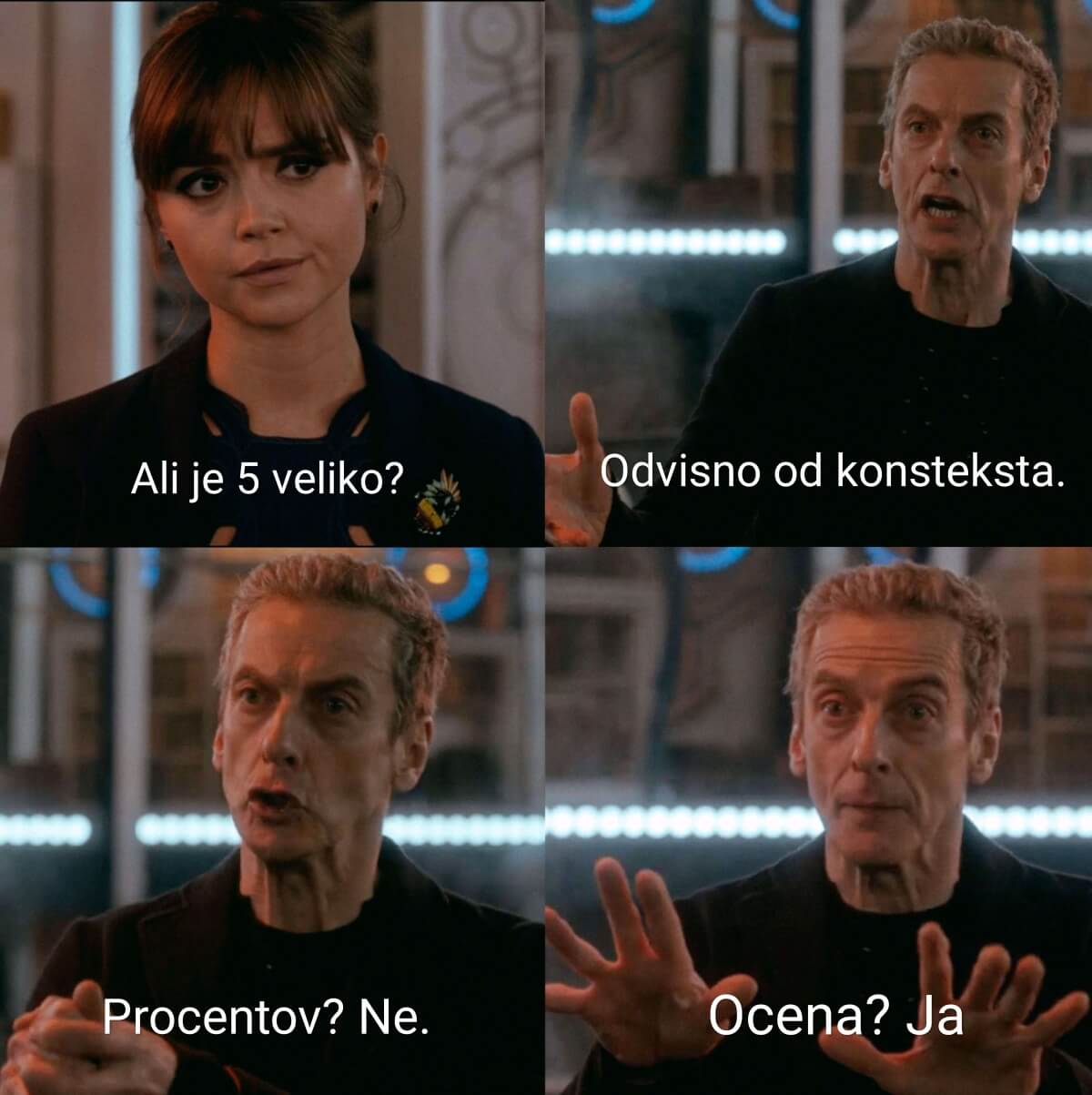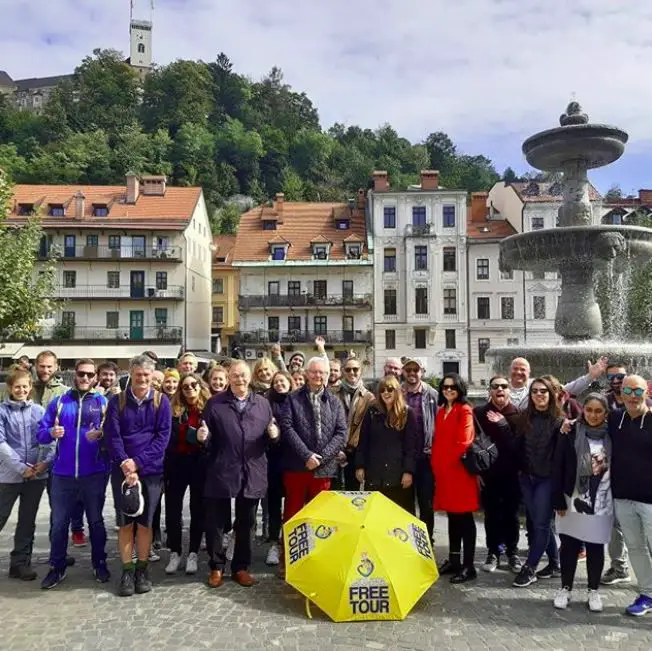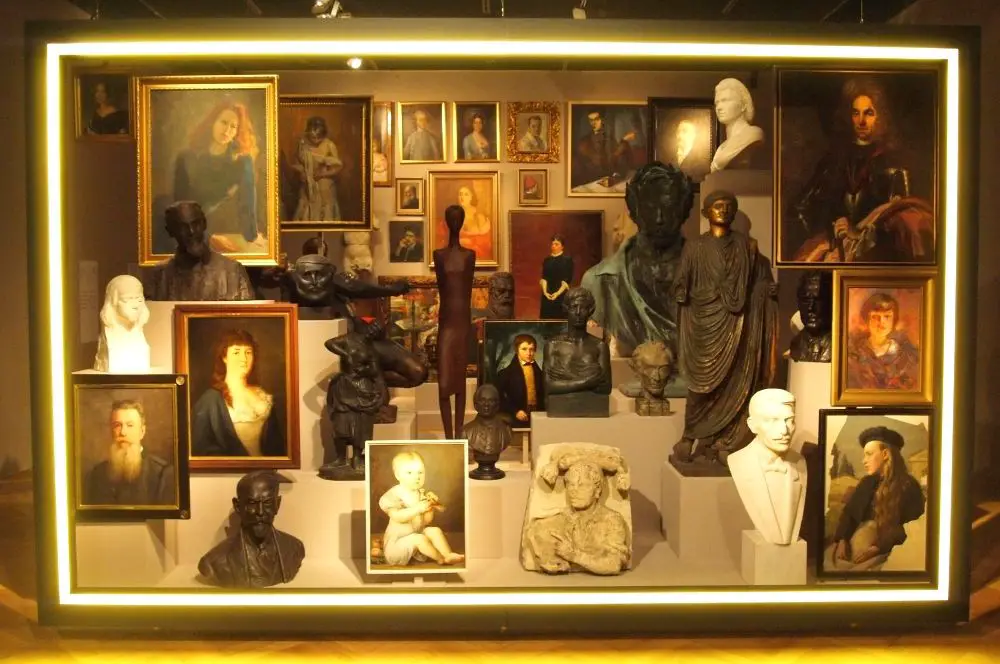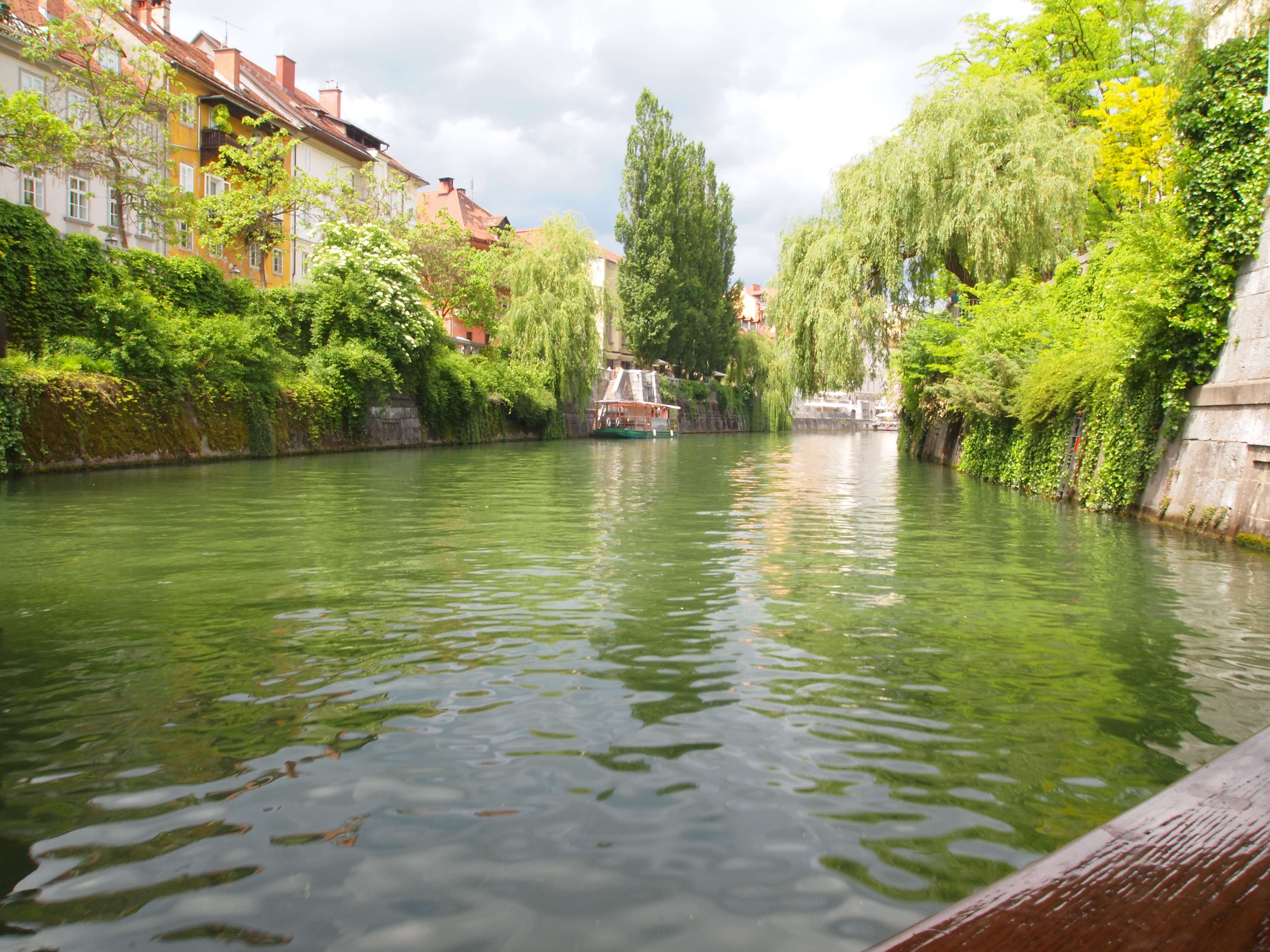Lifestyle
Keep up with the daily news in Slovenia by checking the morning headlines here. What to find out what happened last week in Slovenia? Look no further.
The following schedule was prepared by the STA:
MONDAY, 18 November
LJUBLJANA - The National Assembly will start its plenary for November with a Q&A session for PM Marjan Šarec and his cabinet.
LJUBLJANA - The Slovenian Business Club will present an initiative called For an Entrepreneurial Slovenia highlighting the importance of business for national prosperity.
TUESDAY, 19 November
LJUBLJANA - The National Assembly will start examining the budget bills for 2020 and 2021. A total of 38 hours of debate is scheduled.
BRUSSELS, Belgium - EU ministers in charge of European affairs will be in session. Slovenia will be represented by Foreign Ministry State Secretary Dobran Božič.
KOPER - A joint committee of Slovenia and Friuli-Venezia Giulia will be in session.
BRDO PRI KRANJU - GoDigital 2019, a Chamber of Commerce and Industry (GZS) conference on big data and artificial intelligence.
VELENJE - Future 4.0, a conference bringing together established industrial players and startups.
LJUBLJANA - AIPA, an organisation of rights holders, will present the first ever study about the Slovenian audiovisual industry.
WARSAW, Poland - Slovenia will face Poland in the final round of qualifications for the Euro 2020.
WEDNESDAY, 20 November
BRUSSELS, Belgium - Foreign Minister Miro Cerar will attend a session of NATO foreign ministers; until 21 November.
LJUBLJANA - IMAD, the government's macroeconomic forecaster, will host a debate on labour shortages.
LJUBLJANA - The Chamber of Commerce and Industry (GZS) will host its annual business summit. Innovation and human resources will be the topics in focus.
LJUBLJANA - The national awards for achievements in science and research will be conferred.
CELJE - Chemical company Cinkarna Celje is scheduled to release financial statements for the first three quarters of the year.
LJUBLJANA - AmCham, the US chamber of commerce, will host a debate on Slovenian healthcare.
THURSDAY, 21 November
LJUBLJANA - The National Assembly will vote on several pieces of legislation as well as three bills that have been vetoed by the upper chamber.
LJUBLJANA - Weekly government session.
NOVO MESTO - Drug maker Krka is scheduled to release its financial statements for the first nine months of the year.
KOPER - Logistics company Intereuropa will release its business report for the first three quarters of the year.
LJUBLJANA - Naprej/Forward!, a journalism festival organised by the Slovenian Journalists' Association; until 22 November.
LJUBLJANA - The Statistics Office will release November consumer sentiment figures.
LJUBLJANA - An online Hungarian-Slovenian dictionary will be launched by the ZRC SAZU Institute for Slovenian Language.
FRIDAY, 22 November
BRDO PRI KRANJU - Foreign Minister Miro Cerar will attend a session of a Slovenian-Turkish joint commission.
LJUBLJANA - Insurance group Sava Re is scheduled to release its financial statements for the first nine months of the year.
LJUBLJANA - Tax-Fin-Lex, a legal and tax information provider, will declare the top tax, financial and legal experts of the year.
LJUBLJANA - The National Assembly is expected to hold a special session to debate concerns that the construction of a sewerage system could jeopardise the source of drinking water for Ljubljana.
SATURDAY, 23 November
LJUBLJANA - Awards will be conferred at the Ljubljana International Film Festival.
LJUBLJANA - The start of the 35th Festival of LGBT film; until 1 December.
LJUBLJANA - Slovenia observes Rudolf Maister Day in memory of the general who took control of Maribor in 1918, securing what later became Slovenia's northern border.
LJUBLJANA - Italian crooner Eros Ramazzotti will stop in the Stožice Arena as part of his Vita ce n'e tour.
SUNDAY, 24 November
SKOPJE, North Macedonia - Culture Minister Zoran Poznič will attend a meeting of culture ministers from the CEE region and China.
If you're not in town for the week of this guide (18 - 24 November, 2019) then you can see all the editions here, and if there's event or activity you want to promote in a future edition of What's on in Ljubljana please get in touch with me at flanner(at)total-slovenia-news.com or try and find me on Facebook. If you want something a little different and easy to print, then a comprehensive PDF of events for the next seven days, as prepared by Ljubljana Tourism, is here. If you're in town and want to follow the news then check out our regular morning headlines for Slovenia here.
The public Christmas lights are already up in many parts of town, but they won’t be lit until 17:15 Friday 29 November.
Dance is in the spotlight this week, with the CoFestival international festival of contemporary dance. This runs from 22 to 27 November and takes places at assorted venues around town. Details are here. Fans of art cinema will also much to enjoy, as LiFFe – the Ljubljana International Film Festival is in town, with details here, while Gourmet November continues till the end of the month. Thursday to Sunday the 50th Snežinka Ski Fair will offer visitors a wide selection of new and used ski equipment and presentations of various ski centres.
The LGBT Film Fest opens on Saturday, 23 November, and closes 1 December - details are here.
How much do tourists spend in Slovenia? Find out here
Wednesday, 20 November, you can enjoy the sounds made by Alexander Gadjiev at Cankarjev dom (19:30 – tickets), playing works for the piano by Brahms, Liszt, Chopin, Skriabin, Messiaen and Bartok. That same evening Kino Šiška plays host to Godspeed You! Black Emperor (20:00 – tickets).
Saturday Eros Ramazzotti is playing Stožice Sports Park Arena at 20:00 (tickets). Later than same evening, 23:00, Erick Morillo will be making people dance at Kurzschluss, with tickets here.
The only new movie this week seems to be the following, which – like all kids movies, will usually be shown dubbed (sinhronizirano), so look carefully if you want the original sound (i.e., with subtitles / podnapisi).
Learn Slovene with memes, here
Interested in Slovenian craft beer? Find out what’s new with Damir, of Lajbah and more.
You may have heard about Free Tour Ljubljana, the tour company that’s #1 on TripAdvisor for the city and gives away its main product. What’s the deal with that? Find out here.
While the Old Town is quaint, and full of music, where does Ljubljana really shop? One popular answer is BTC City, a vast complex of malls, entertainment facilities and more, including more than 70 different food vendors, offering everything from Slovenian to Thai, Indian to Italian, Mexican to Chinese. Check out my recent visit here.
Looking for something different to eat? Trubajeva cesta, running right by Dragon Bridge, has the greatest concentration of "ethnic food" places in Ljubljana, and thus perhaps the country. Check out our walk through guide as of June 2019.
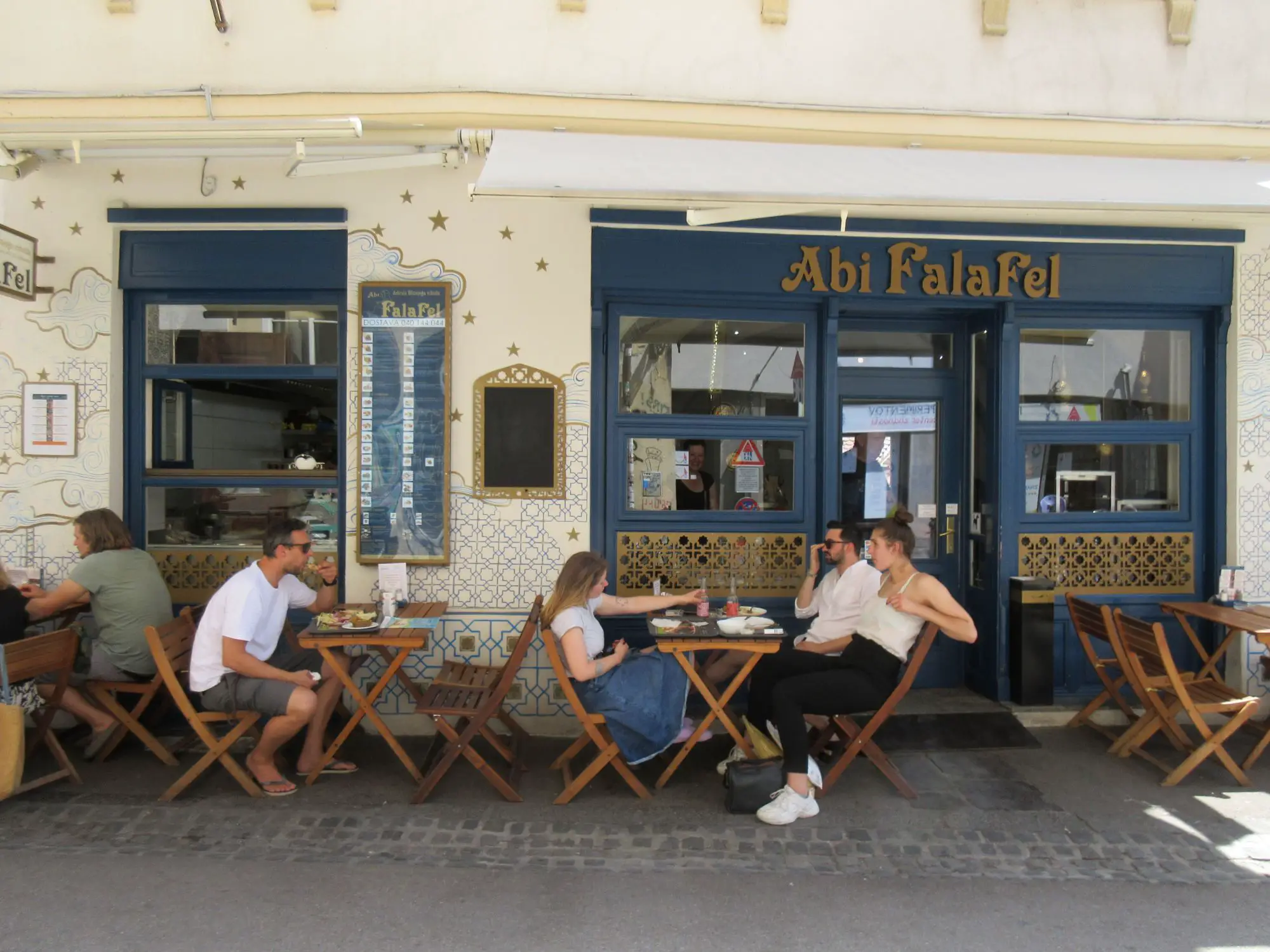
In warmer days than you'll see this week. Photo: JL Flanner
Ljubljana is forecast to be the fastest-warming city in the world over the next few decades.
You're in the town of Slavoj Žižek, but do you find yourself lost when conversation turns to the philosopher? If so, check out our collection of quotes and clips to learn more.
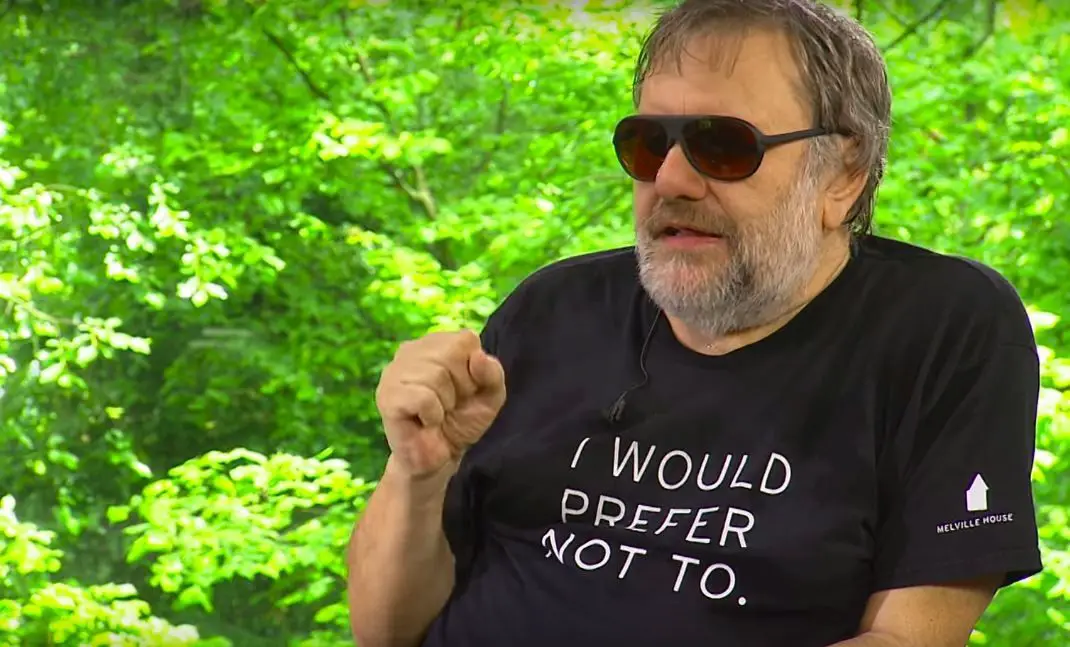
Screenshot from YouTube
- Cinemas and films
- Clubbing
- Live music
- Theatre and dance
- Harm reduction and drug testing
- Things to do with children
- LGBT+ Ljubljana
- Ljubljana Castle
- Museums and galleries
- Other things to do in Ljubljana
- Daytrips
- Getting around
- Emergencies
Cinemas and films
You can read about all the cinemas in town here, while a selection of what’s playing this week is below, and note that kids' movies tend to be shown in dubbed versions, while non-English language movies for older viewers will have Slovenian subtitles.Parents should also pay attention to Kinobalon, which is Kinodvor's regular weekend series of film screenings and events for children, from babies on up, with special parent/child events, "first time in a cinema" screenings, and babysitting. Learn more about it here, and see the current schedule here.
Note - most children's films will be dubbed (sinhronizirano) - for subtitles look for 'podnapisi'.
Kinodvor –This is an arts cinema, not far from the train station, that shows new features as well as hosting the occassional festival.
Kinoteka – And not far from Kinodvor you can find this revival cinema, which shows art house classics along with some deep dives in the archives.
Kino Bežigrad - A relatively small theatre, but one which usually has the biggest of the new releases.
Kolosej -The multiplex out at BTC City Mall shows all the big movies, with well over a dozen titles on the schedule, although note that there are far more movies than screens, so some of the older ones mayonly be playing once or twice a week.
Komuna – The cinema in a basement behind Nama department store shows two or three different features a week, usually including the biggest titles.
Looking for a souvenir you'll really enjoy? Take a look at Broken Bones Gin, the first gin made in Ljubljana (learn more here, and try it at the Central Market or selected downtown bars).
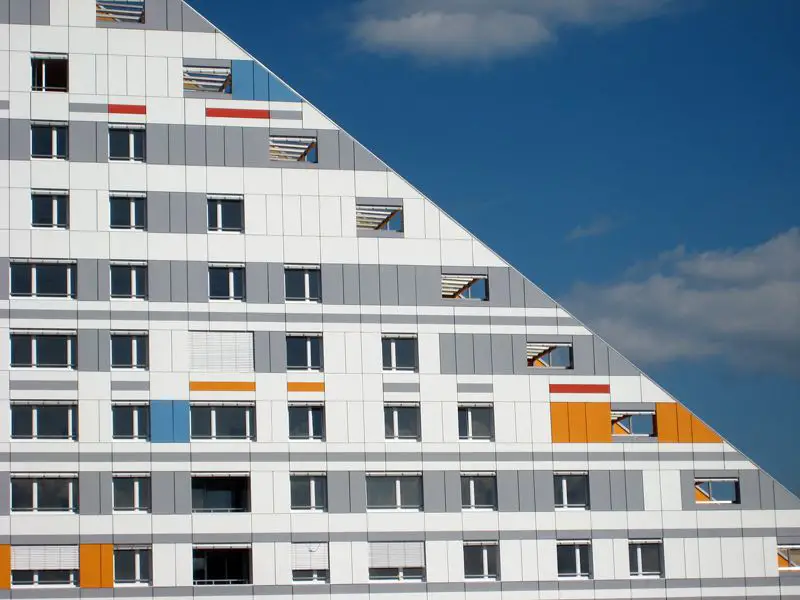
Photo: Genius loci d.o.o.
Know that big triangular building behind the train station? Learn what's inside here.
Clubbing
Compared to some European capitals it can seem that nightlife in Ljubljana ends rather early, especially along the river, but there are still bars that stay open late and clubs were you can dance until dawn, and perhaps the best place to stumble across something interesting is the legendary Metelkova. Be aware it's a grungy kind of place and not for all tastes, but also that there's considerable variety to found within the various clubs there, from death metal to electropop, gay cabaret to art noise. You can read "the rules" of the place here. And if you're curious about how the place started then read our story, and look at some pictures, about last year's 25th anniversary.
Božidar - DJ events aren't too common here, but when they happen they often have a big name.
Channel Zero – DJs shows here include regular dub nights as well as electronic music.
Gala Hala – Another Metelkova venue, you can sometimes hear bhangra and Bollywood here, but more often funk, hip hop, breakbeat and so on.
Klub Cirkus – The more commercial end of clubland, and a venue that aims to serve the student party scene. Expect house, anthems, and bangers.
Klub K4 – The home of techno, old and new, along with various other electronic genres,
Koncertna Dvorana Rog– There are irregular DJ sets at this underground (not literally) venue at the far end of Trubarjeva cesta, and they range from techno to goa to drum'n'bass.
Orto Bar– 80s and 90s throwback nights can often be found here, along with rock-based DJ sets.
Live music
Balassi Institute – Free Hungarian music, when available, from the Hungarian cultural institute just a short walk downriver from Dragon Bridge.
Cankerjev dom – The main arts venue in the country hosts classical, opera jazz, folk and occassinally pop.
Cvetličarna – Regional pop and rock concerts can be found here.
Channel Zero – This Metelkova venue sees live shows from punk and rock bands, as well as others.
Gala Hala – Another Metelkova venue with indie bands of various styles.
Kino Šiška – One of the top live venues in the city, with a varied programme that include indie, rock, pop, experimental, hip hop, and so on.
Klub Gromka – Live music is often metal, from sludge to stoner, death to thrash, while punk bands also appear, as do others.
Križanke – The venue that hosts the Ljubljana Festival often has classical music, and some rock, in the open air.
Orto Bar– The home of live rock, metal, punk and other guitar-based genres.
Pinelina dnevna soba – LIve music is rare here, but it does happen.
Slovenska filharmonija– Classical music in the centre of town.
SNG Opera and Ballet - As the name suggests, here you'll find the best of opera and ballet in the country.
Španski borci - While dance is more common here, they also have some contemporary and experimental music shows.
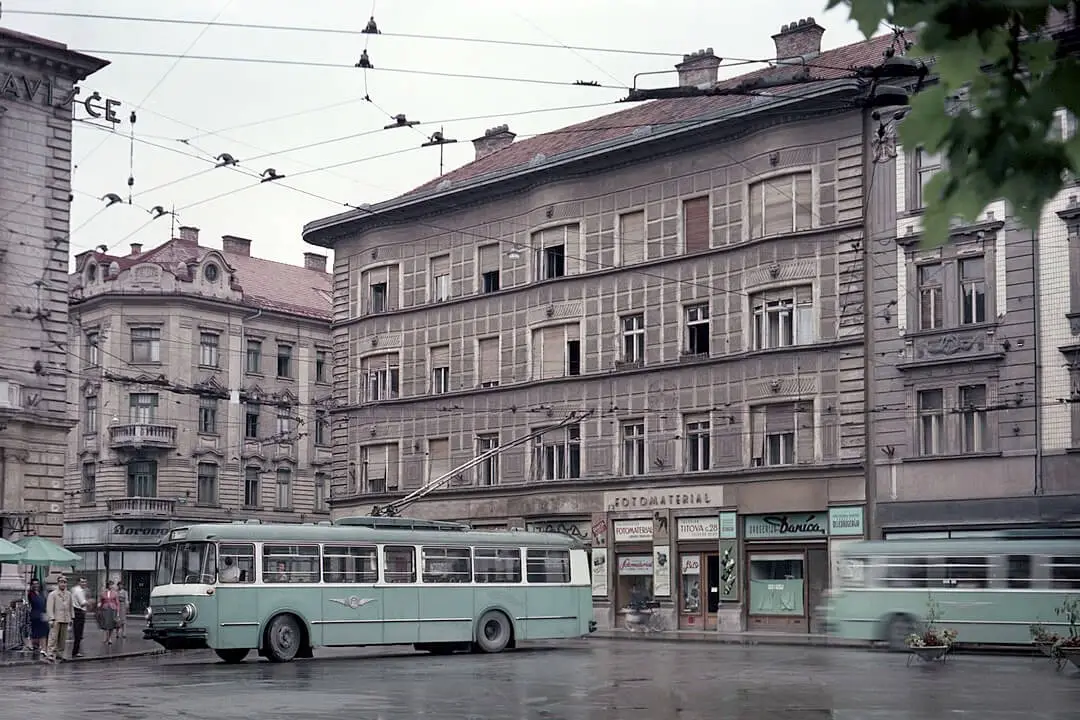
Slovenska cesta, 1959. Wikimedia. See more pictures of Old Ljubljana here
Theatre and dance
Cankerjev dom- The main arts venue in the country always has something of interest going on.
Gledališče IGLU - IGLU Theatre – Saturday night this group is usually putting on an English improv show somewhere in town, but it’s generally promoted after this is written, so check the Facebook before putting on your shoes.
Kino Šiška – One of the top live venues in the city also hosts some dance performance, often of the more experimental variety.
Mini Teater Ljubljana –The English schedule of varied performances, for adults and children, for the month is here.
Ljubljana Puppet Theatre - Puppetry has a long and noble tradition in Slovenia, and you can see performances for children and adults (including non-puppet shows) drawing from the Theatre's rich repetoire as well as new productons.
SNG Opera and Ballet - As the name suggests, here you'll find the best of opera and ballet in the country.
Španski borci - The home ofcontemporary dance(and the EnKnapGroup) in Slovenia.
Pocket Teater Studio– There are regular flamenco evenings at perhaps the smallest venue town, but note that the number of seats is very limited, and thus you should make a reservation via This email address is being protected from spambots. You need JavaScript enabled to view it. or 070 325 522.
Harm reduction and drug testing
Drogart is an organization that aims to minimise harm on the party scene, and offers drug-testing services and reports on their webpage. It’s in Slovene, but you can Google translate it or work things out yourself, and our story on the group is here.You can find the latest warnings on fake drugs and high strength pills and powders (in Slovene) here. However, be aware that all the usual drugs are illegal in Slovenia.CBD is legal, though, and our retailer of choice can be found on Trubarjeva cesta - read more about Sena Flora here.
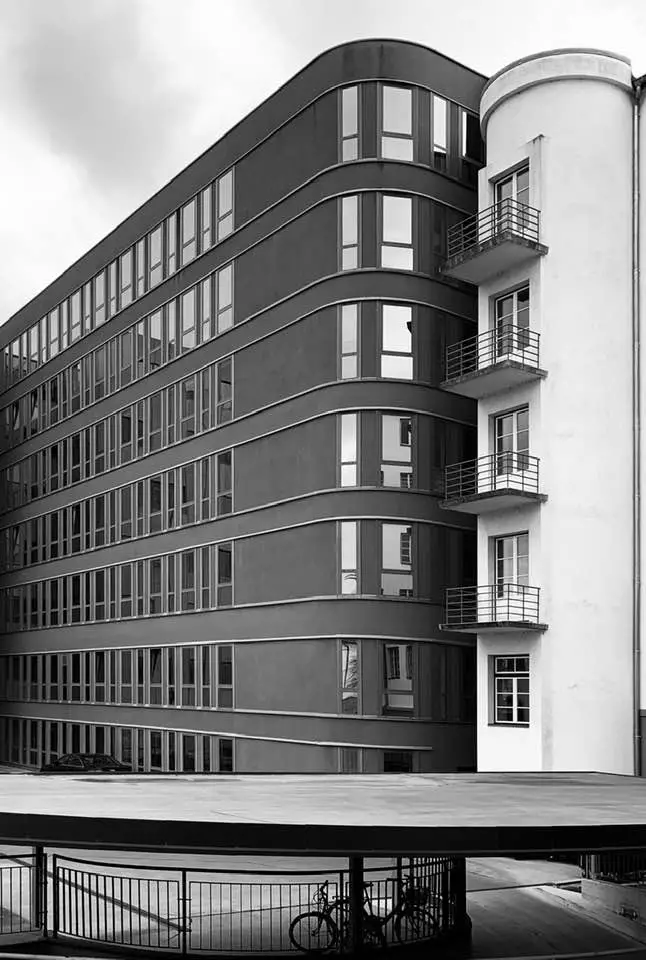
Photo: Igor Andjelič. See more of his work here
Things to do with children
You can find our Top 12 list of things to do with kids in Ljubljana here. If want to read more about the philosophy behind the wonderful House of Experiments look here, while our trip to the Museum of Illusions is documented here, and there’s always riverside walks, pizza and ice cream. With regard to the latter, take a look at our guide to six places that serve good ice cream in winter, and thus are serious about the dessert.
Mini Teater Ljubljana – The season sees a lot of puppet performances for children, in Slovene, at this theatre not far from Križanke. The English schedule for the month is here.
Ljubljana Puppet Theatre - The puppet theatre near the Central Market and next to the Castle funicular has a full programme or shows, for children and adults, with the schedule here.
LGBT+ Ljubljana
If you're looking for more general links on "gay Slovenia", including a history of the scene and various projects, then you can find that here, while our stories about the community can be found here.
Klub Monokel – This lesbian bar in Metelkova is open every Friday, although sometimes there are other events
Klub Tiffany –And the gay bar next door is also open on Fridays. Other things coulds also be planned, so click on the name to find out.
Pritličje – This seems to be the only "always open" LGBT-friendly cafe / bar / events space in town, and perhaps the country, so it's a good thing it's such a good one, open from morning to night, and with fliers and posters letting you know what's happening outside the narrow confines of, say, a general interest online what's on... guide.
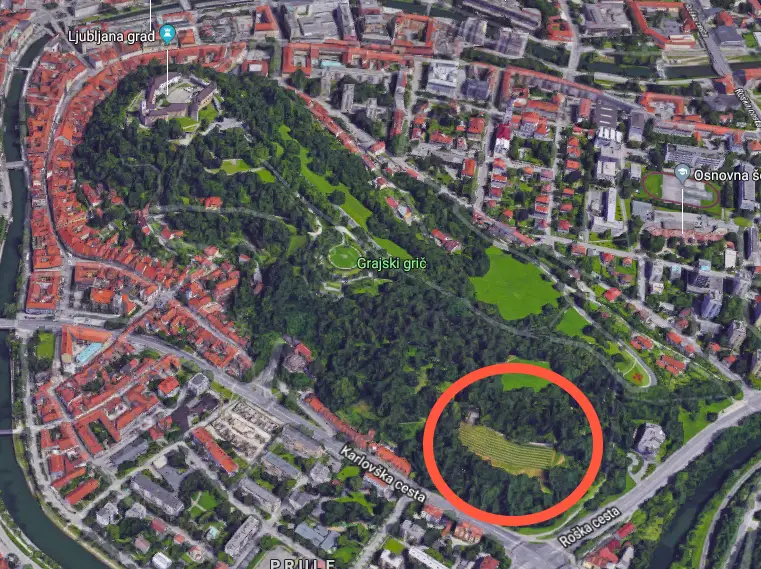
Screenshot from Google Maps, showing the location of the Castle vineyard
Ljubljana Castle
The city’s main attraction is said to be the top tourist draw in the country overall, and to my mind it earns a spot near the top just for the history and views. But beyond that the current owners, the City of Ljubljana, have laid out a varied, interesting and enjoyable programme of events, one that rewards regular revisits. On until 17 November Mighty Guardians of the Past: Castles in the Slovenian Lands, a presentation that delivers on the promise of its title.
I try and get up there every Saturday morning to clear my head and move my feet on the trails, and never tire of that end of the hill. At the other end, where the Castle sits, there’s a lot more than fresh air on offer. There are guided tours, restaurants, a café, Castle museum, puppet museum, a Watchtower you can climb to the highest point in the city, art shows, dances, live music, movies under the stars, festival days and more – enough to reward multiple trips up the hill through the year. All of these activities and events can be found on the Castle website, while on TSN you can see “25 things to know about Ljubljana Castle” here, and “Ten Ways to Enjoy Ljubljana Castle” here.
Museums and galleries
Most public galleries and museums are closed on Mondays, although not the National Museum.
Bežigrajska galerija 2 – Take a trip to Vodovodna cesta 3 and until 8 February 2020 you can see Lojze Spacal (1907–2000): From the Littoral and the Karst Region.
Cankerjev dom – On until 3 March 2020 there's an exhibition on Ancient Greek Science and Technology. Details here.
Plečnik's desk. Photo: JL Flanner
Plečnik’s House is worth a visit if you want to learn more about the architect who gave Ljubljana much of its character, and it's also in a really nice part of town, Trnovo, just a short walk or cycle upriver. Read about our guided tour here. On until January 2020 you can see plans and models for some of the things Plečnik planned but never built in Ljubljana. Take a look at some pictures here.
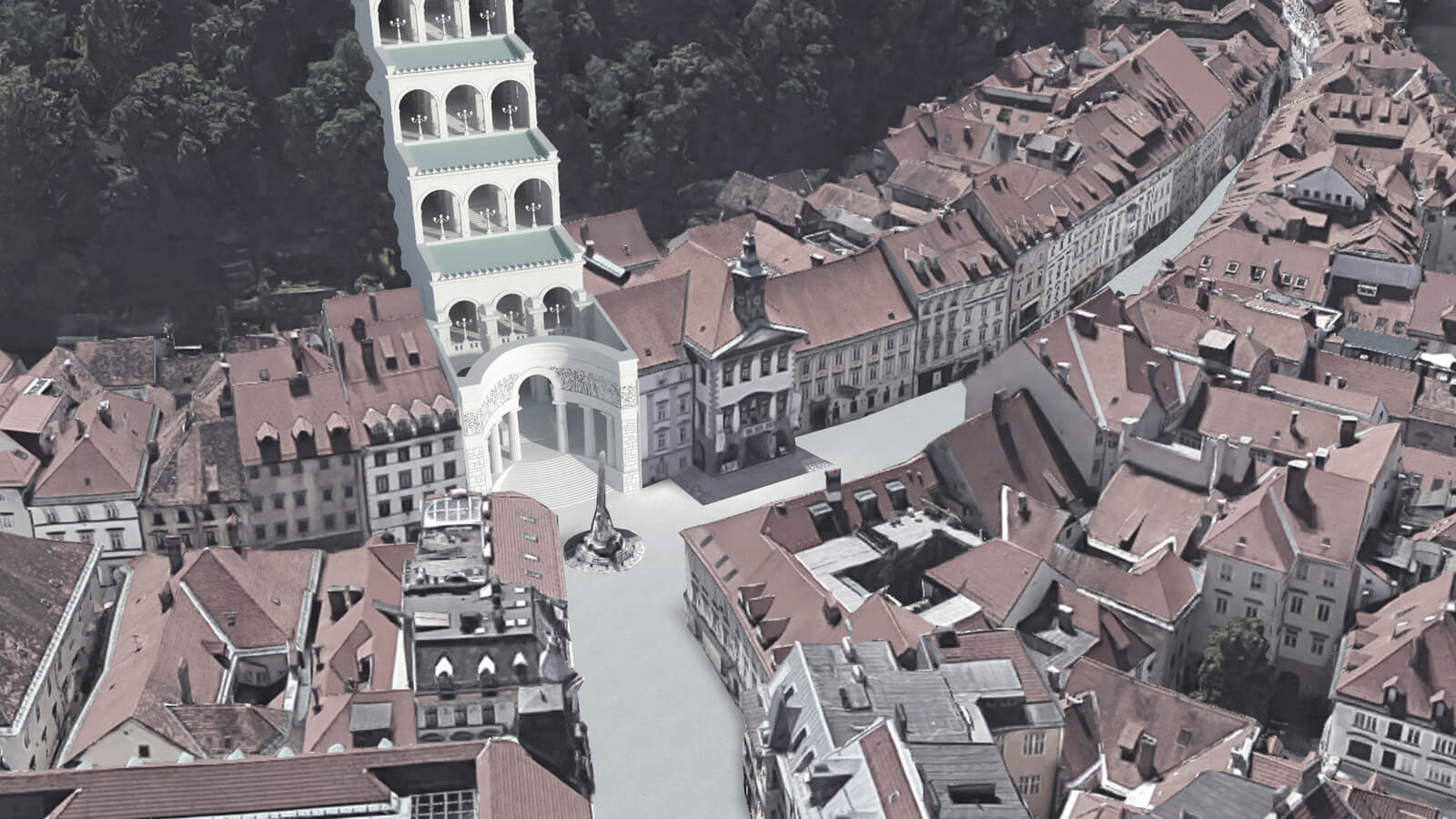 Image: Nejc Bernik. ZRC-SAZU
Image: Nejc Bernik. ZRC-SAZU
Balassi Institute – The Hungarian culture centre is next to a Spar and Hofer, and not far from Dragon Bridge, and always has something interesting going on. Learn more here. This month there's also an exhibition with more works like the one shown below for a show described as follows: “The concept of the exhibition “Awkwardly Close” in Balassi Institute is exactly the self-conscious unease coming from artistic and content similarities between the works of Kata Bereczki, and the Slovenian artistic collective Son:DA."
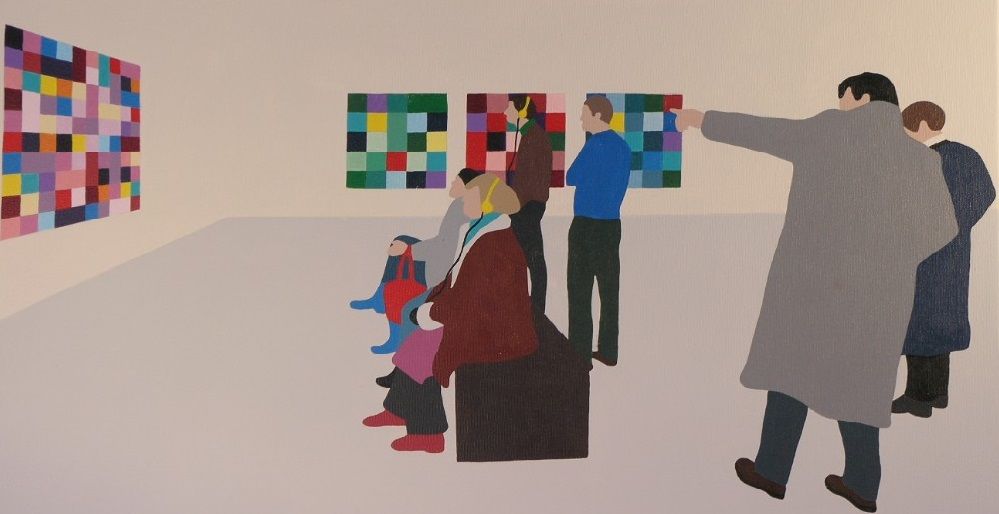
City Gallery - From 28 November until 19 January 2020 there's a sculpture by Jiři Bezlaj.
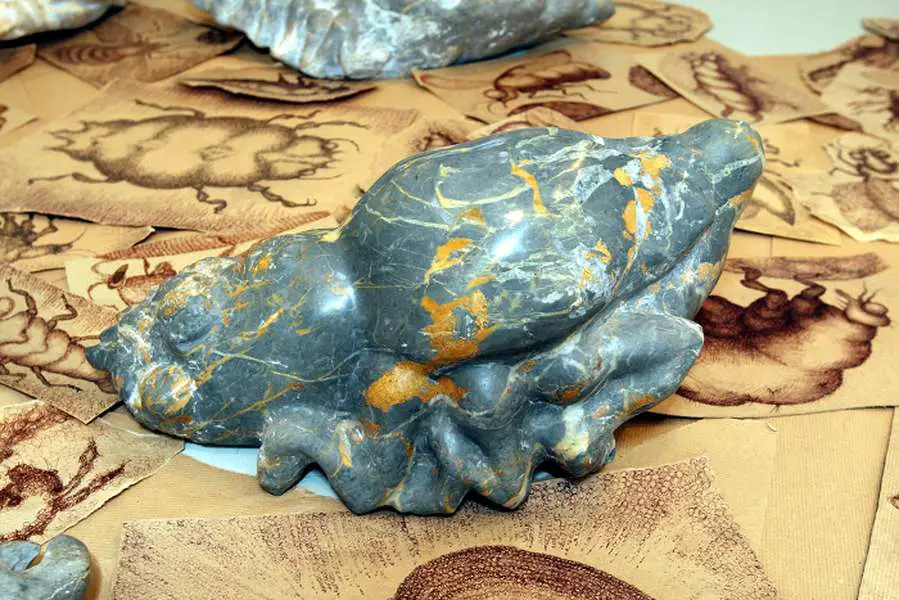
Jiři Bezlaj, Hrošč, 2010 - 2016. Source: Mestna galerija
City Museum – The Museum in French Revolution Square an interesting permanent exhibition on the history of Ljubljana, from prehistoric times to the present day, with many artefacts, models and so on that bring the story alive.You can read about my visit here
The Faces of Ljubljana in the City Museum. Photo: JL Flanner
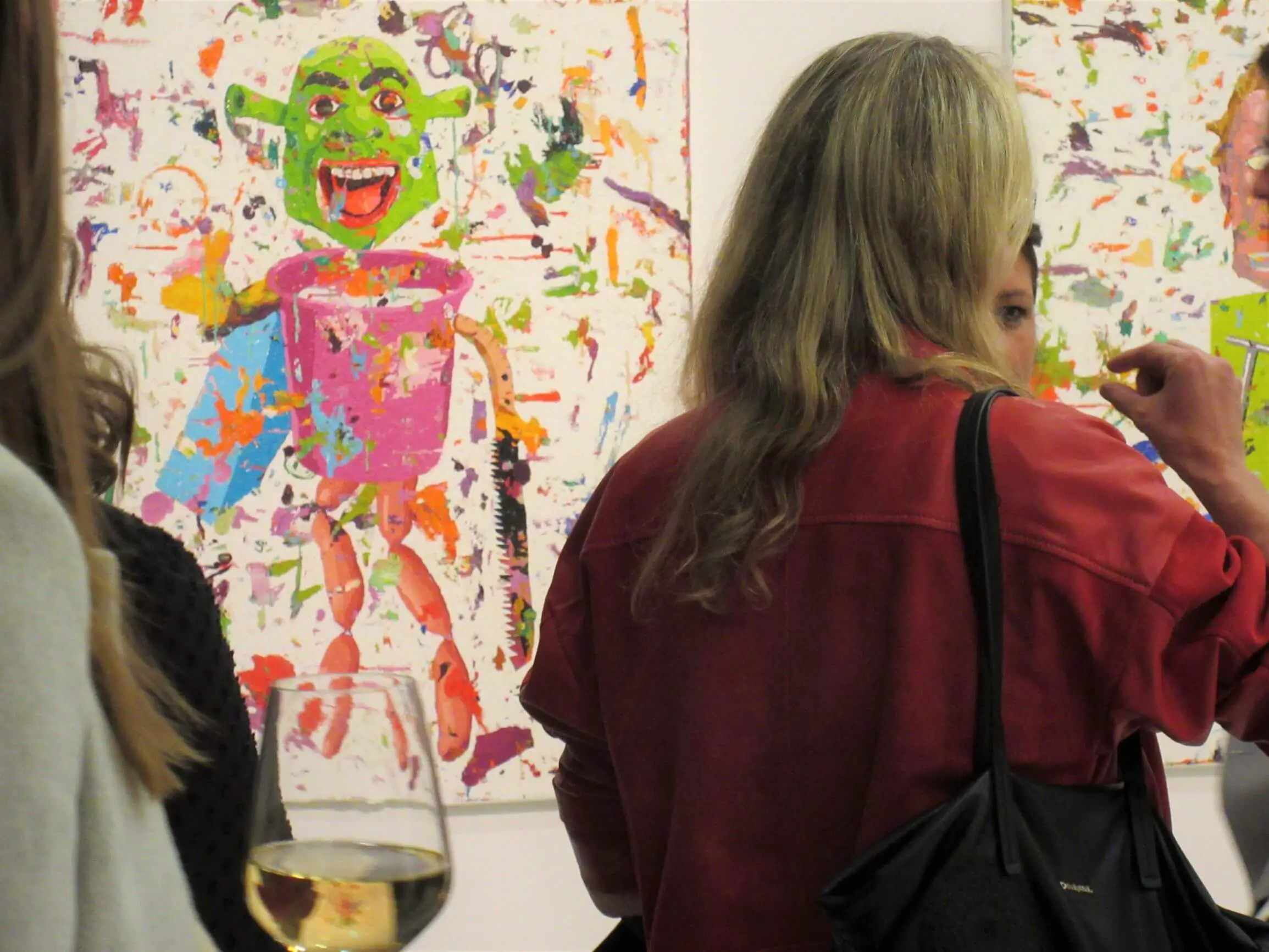
Drink like a pro - find gallery openings. Photo: JL Flanner
Ljubljana Castle on until 17 November Mighty Guardians of the Past: Castles in the Slovenian Lands, a presentation that delivers on the promise of its title. New at the Castle is (Un)known Ljubljana, a free to enter National Geographic exhibition with photographs of some of the lesser seen parts of the city, with one example below and more here.
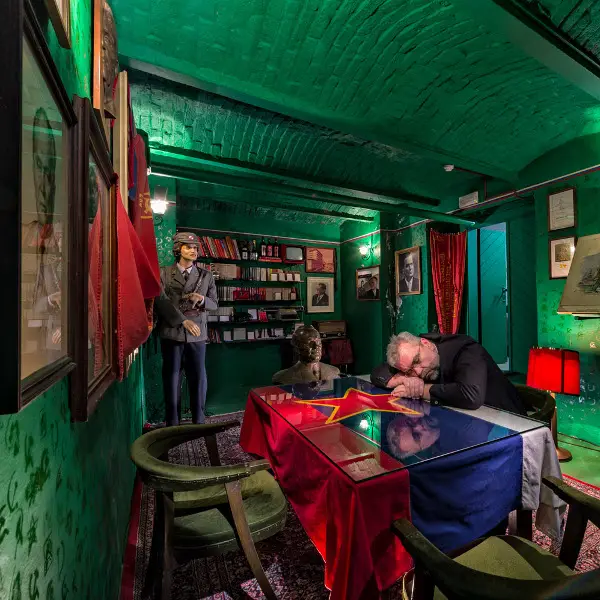
MAO – The Museum of Architecture and Design has much of what you'd expect, along with some temporary shows and a good cafe.
Moderna galerija – The main branch of this gallery, to be found near the entrance to Tivoli Park, has a good collection of modern art, as well a nice café in the basement. The 9th Triennial of Contemporary Art U3 is also on here until 12 January 2020. Titled Dead and Alive: “The exhibition unfolds around three contradictory states of now – the dead and alive state of conceptualism, analogue and liquid materiality, and the subconscious as the battlefield of cognitive capitalism. Because – how do art and avant-garde progress? By making sensible what is beyond. At the end of the day, Dead and Alive is a quantum time search for an engaged form.” More details here, on one of the works on show below.
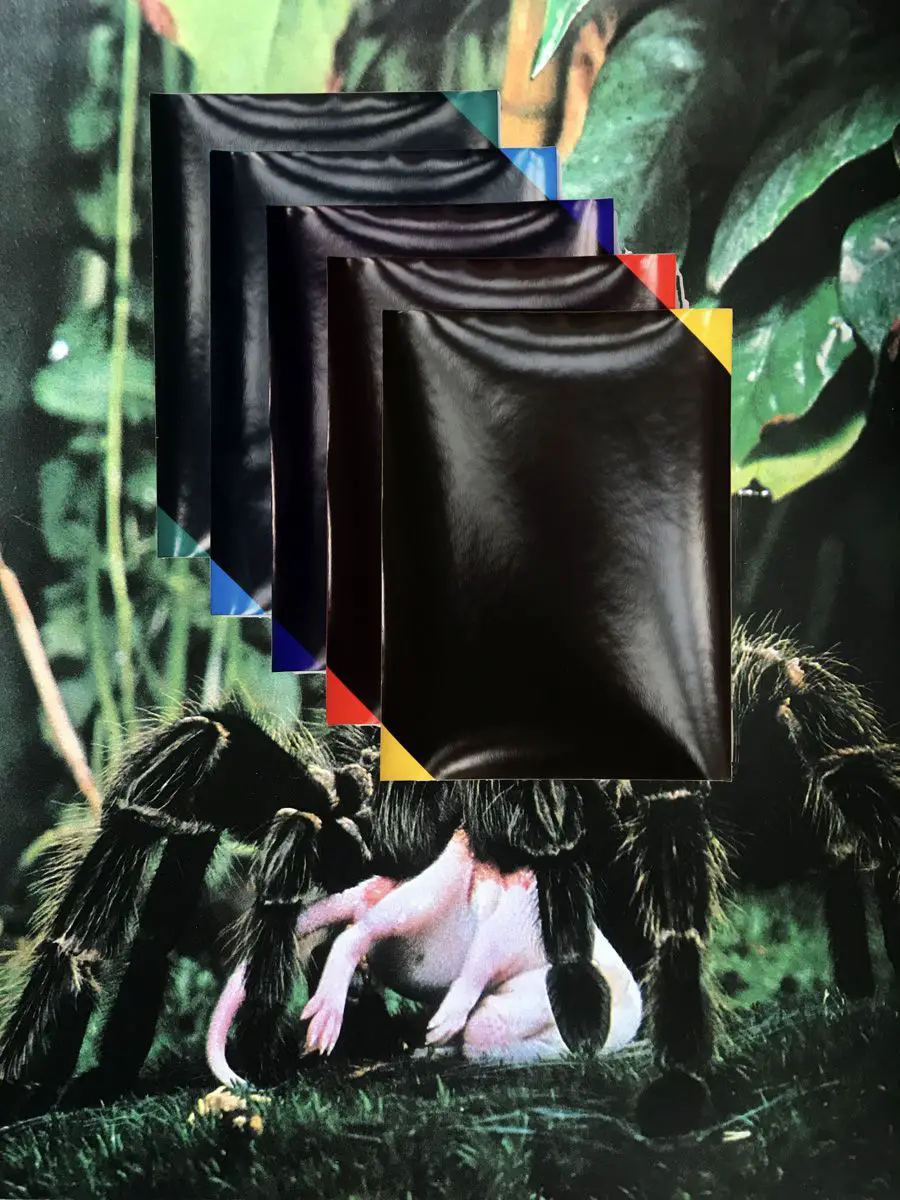
© Aleksandra Vajd, Collage by K. E. Graebner Nature the Unknown Acquaintance (1971) and a unit of five hand-dyed photograms titled: ‘rivalry of superior vs. inferior’, 2017
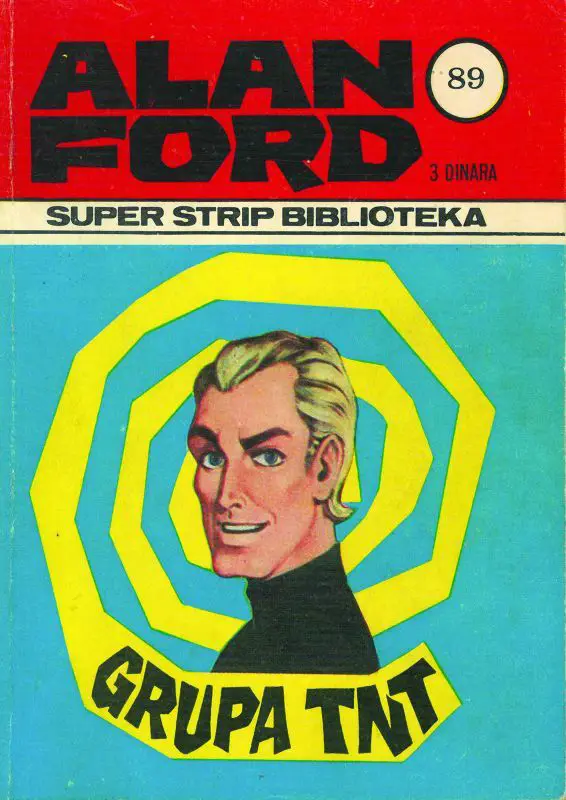
Alan Ford was recently at the National Gallery - read more about this comic book here.
National Gallery – The country’s main gallery has “the best” of what’s on offer from the Middle Ages to non-contemporary modern visual arts, and is in a great location for exploring other areas, just by Tivoli Park and opposite the main branch of the Moderna galerija. You can read about our visit to the room containing sacred art from the Middle Ages here. Art for the Brave New World runs until 5 January 2020: “The exhibition will present the beginnings and development of an early government art collection in Slovenia, which, despite the economic and political crisis, was created in the 1930s by artistic and professional personalities gathered around Dr Marko Natlačen, the last ban of the Drava Banovina.”
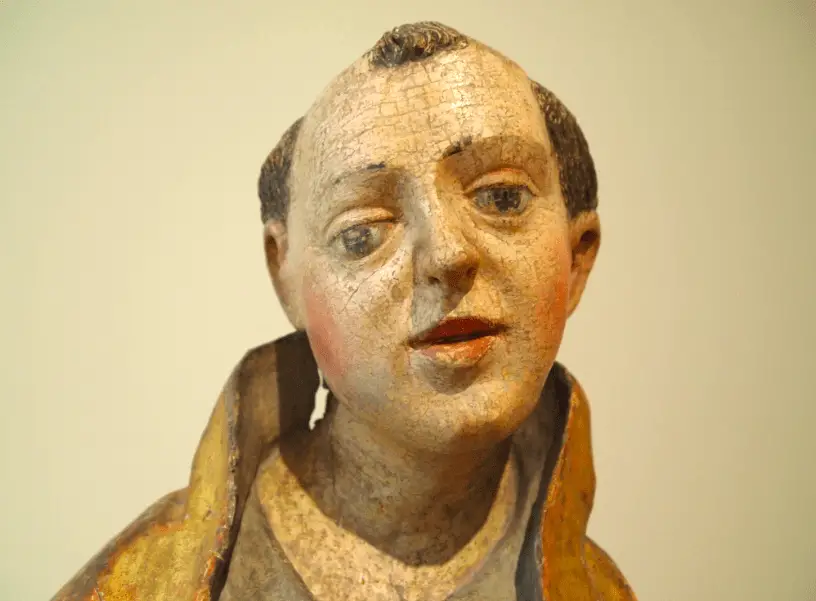
JL Flanner
The real Robba Fountain can be found in the entrance to the National Gallery - the one you see in the Old Town is a genuine fake, as seen below and reported here.
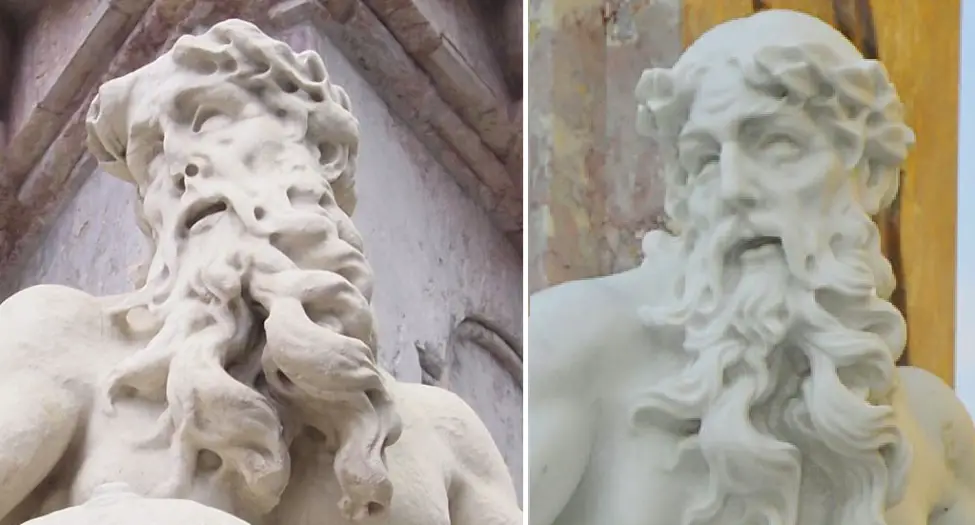
Photo: JL Flanner
National Museum of Slovenia – There’s plenty to see in the permanent collection here, from Roman times, Egypt and more. Meanwhile, the museum's Metelkova branch, located between one branch of the Moderna galerija and the Ethnographic Museum has some rooms on Church art, furniture and weapons, with the latter including more guns than you'll see anywhere else in town, and quite a thrill if coming from a nation where such objects are not household items.
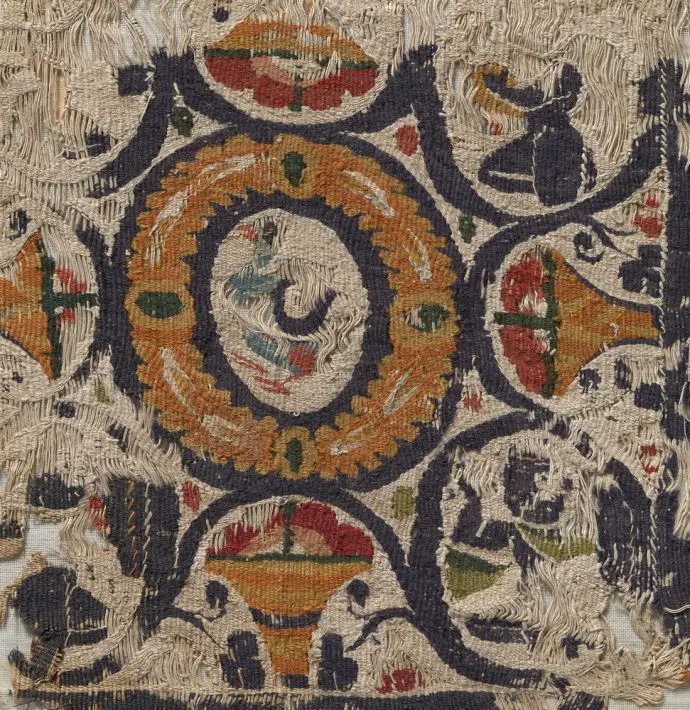
A fragment of a Coptic textile; 5th–6th cent.: Upper Egypt; linen, wool; National Museum of Slovenia. Photo: Tomaž Lauko
Until 24 May 2019 you can see Coptic Textiles from the Collection of the National Museum of Slovenia at the branch in the Metelkova museum quarter, by the Ethnographic Museum and the Museum of Contemporary Art. Details.
Natural History Museum – On until the end of December 2019 is Our Little Big Sea, which takes a look at the oceans.
National Museum of Contemporary History - Tucked away in park Tivoli, you can see a permanent exhibition on Slovenians in the 20th century.
Slovene Ethnographic Museum – The museum has two permanent exhibitions. One of these is called Between Nature and Culture, and has a great collection of objects from Slovenia and around the world, well worth the trip up to the third floor to see it (as recounted here).
Vžigalica Gallery – From 12 November to 1 December there's going to be a show from called SAEBORG: SLAUGHTER HOUSE 17 from the Japanese artist Saeborg which is being promoted with the following image. Details here.
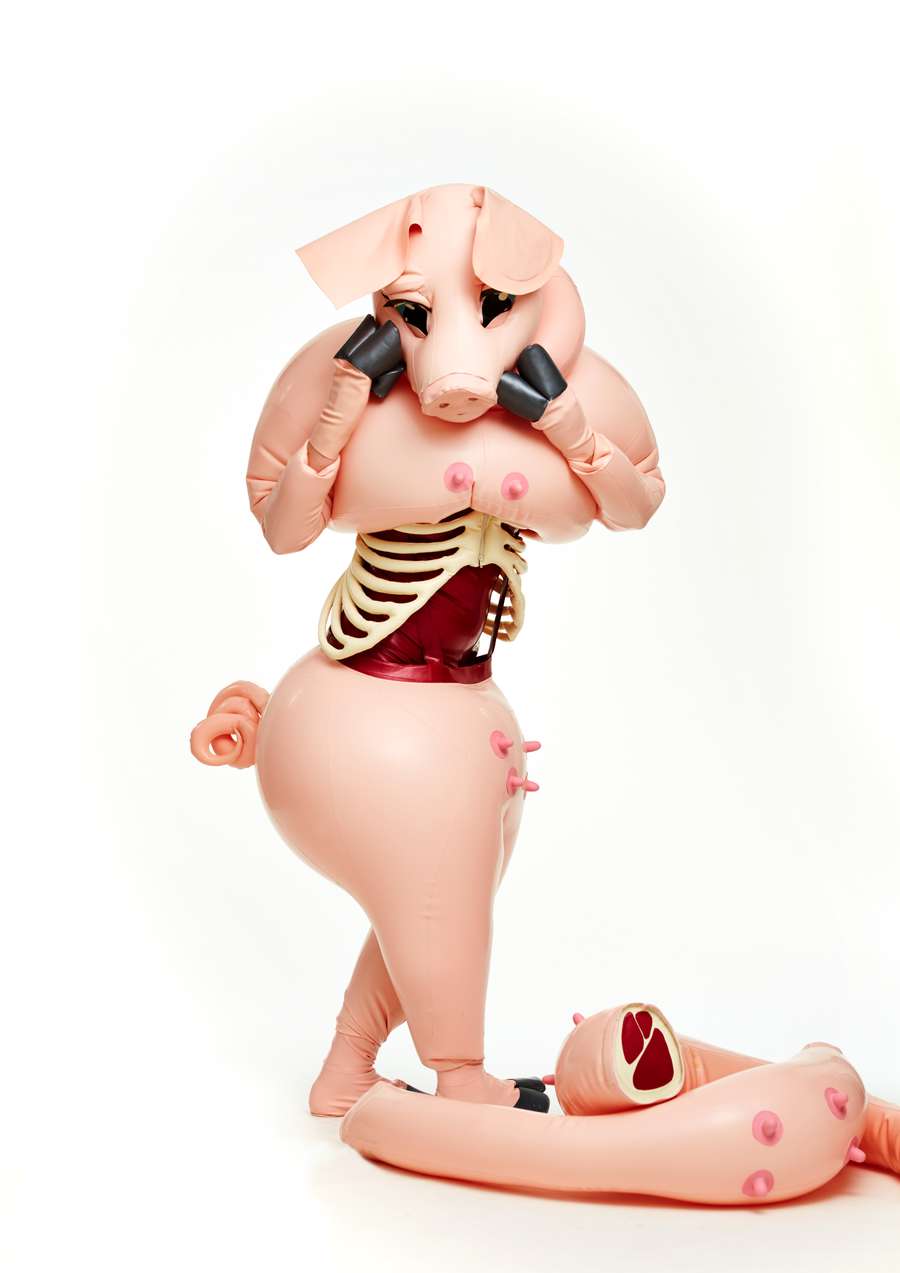
SAEBORG: SLAUGHTER HOUSE 17. Photo: © DARKMOFO
Union Experience – The Ljubljana-based brewer has a museum showing the history of the company, with the ticket also including access to part of the factory and a few samples of the product. You can read about our visit here.
Volčji Potok Arboretum - Running until 3 November you can see a large collection of cacti here.
It's not a formal museum, but if you're interested in "Yugo-stalgia" then you'll enjoy a trip to Verba, a small, privately run space that's crammed with objects and pop culture items from the era, and is conveniently located at the start of one of the short walks to the castle. It's also a great place to take pictures, if you leave a donation, and you can read more about it here.
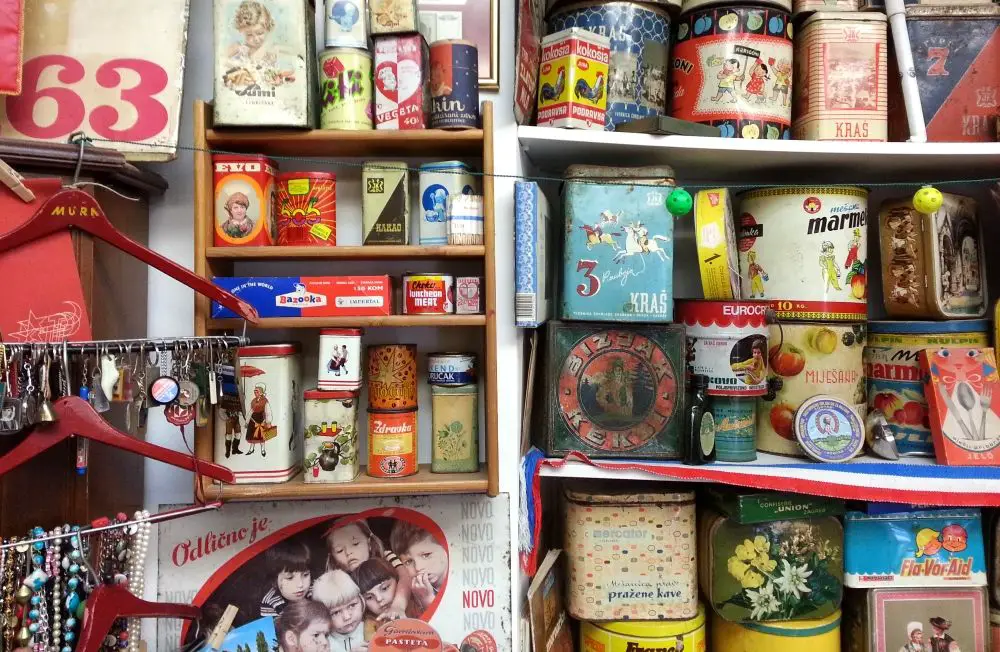
Verba. Photo: JL Flanner
Alternative Ljubljana isn't a museum or gallery, as such, but instead turns the city streets into a museum and gallery. Learn more about their tours of street art, history and LGBT Ljubljana here.
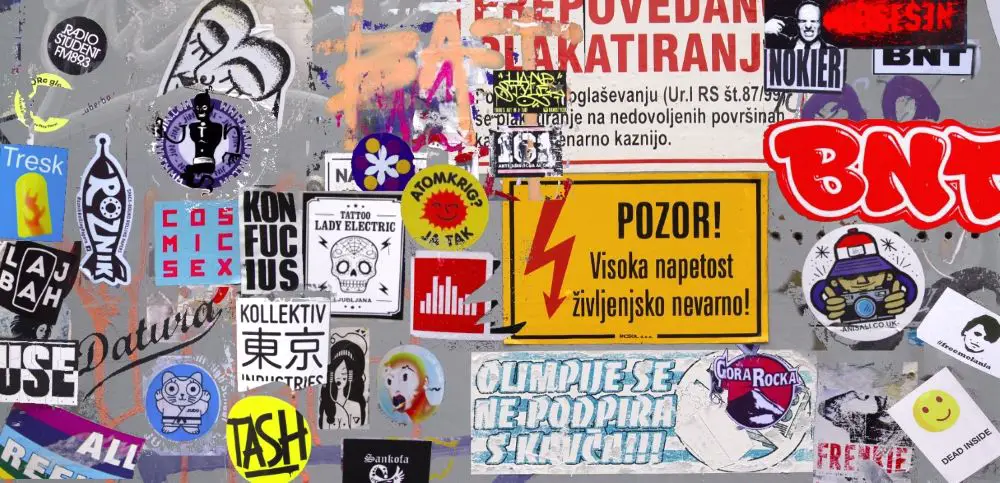
Photo: JL Flanner
Other things to do in Ljubljana
Learn more about Ljubljana with "25 things to know about Slovenia's green city of dragons", or take a look at our guide to spending from four to 48 hours here.
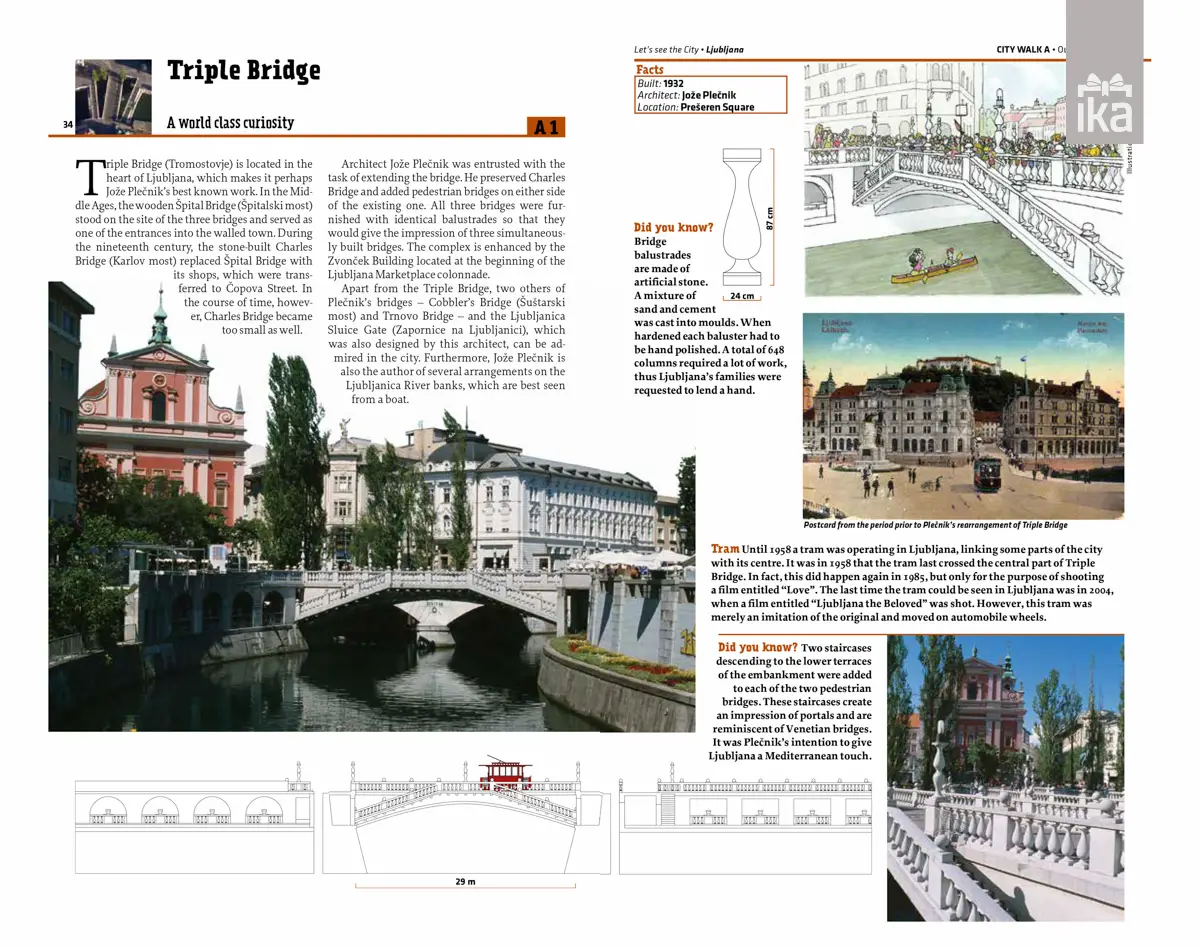
If you like the city's architecture then check out this great book, Let’s See the City - Ljubljana: Architectural Walks & Tours, with our review here and a page from the book shown above. We took a walk with one of the authors who showed us how much there is to learn and enjoy if you slow down and pay attention - read about that here.
Ljubljana has some beautiful buildings from the early 20th century, in the Secessionist style, like the one below. Learn where to find them here.
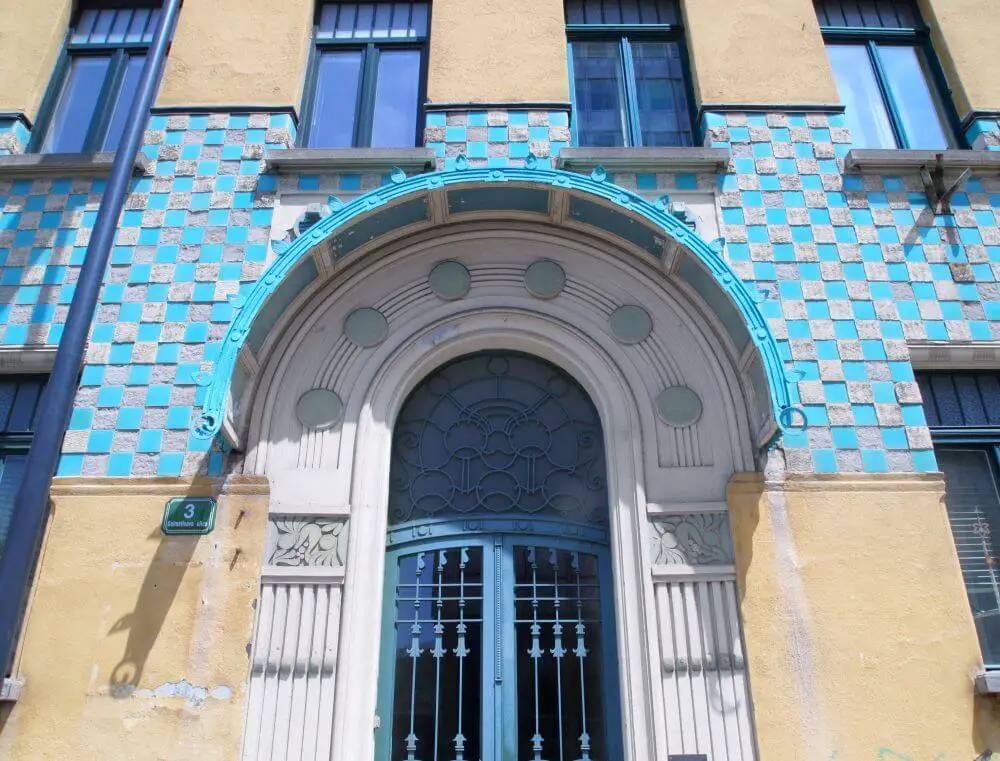
Photo: Neža Loštrek
For something a little more brual, check out Republika trg / Republic Square, in the heart of the political quarter.
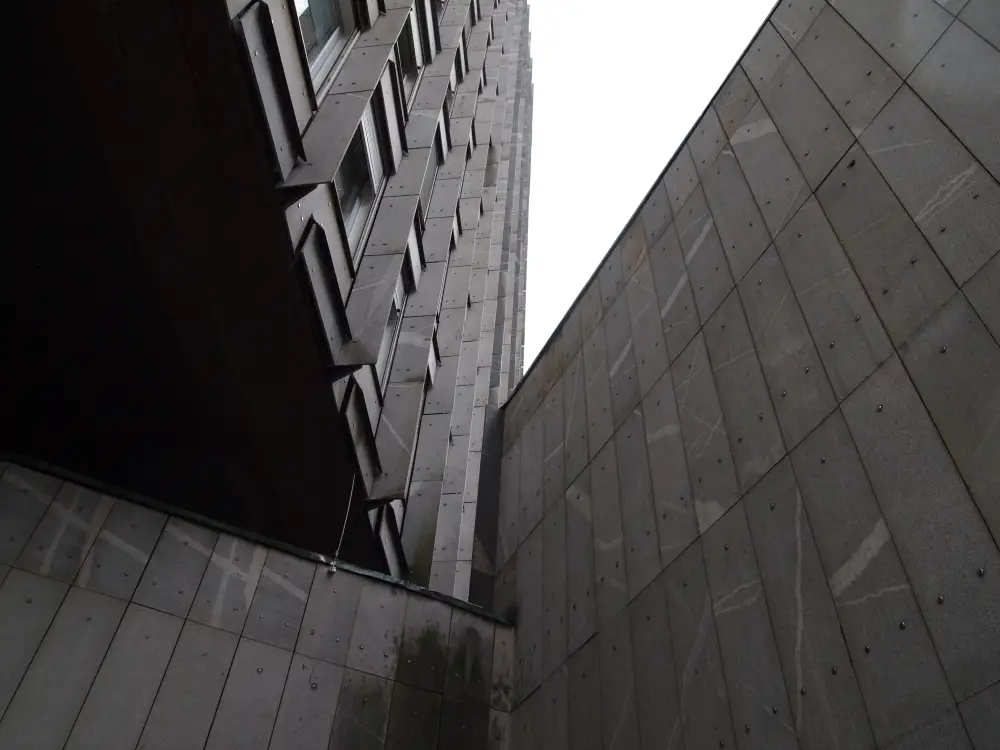
Photo: JL Flanner
Photo: JL Flanner
Some view of the city you can only get from the river. If you'd like to take a boat ride then read about my experience here. If you'd like to spend an evening painting with others, then take a look at Design with Wine, which organises painting parties on Trubarjeva cesta,
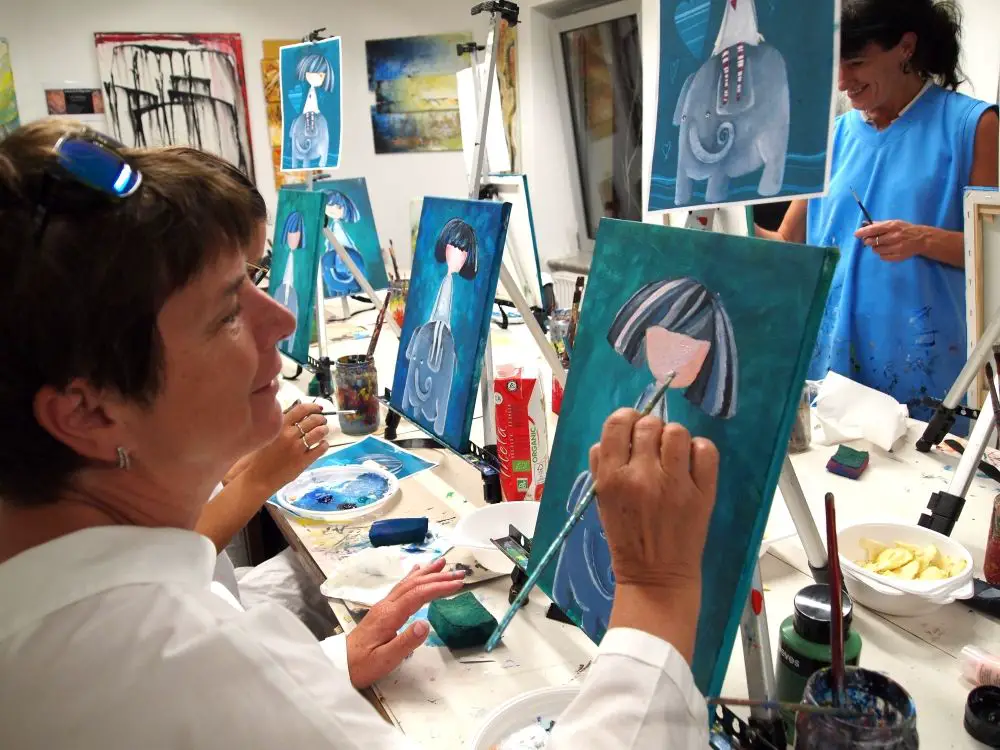
If you want to see some antiques, then check out the wonderful Antika Carniola, as discussed here. The man behind it, Jaka Prijatelj, has a fine eye for life on this street, as you can see on his Facebook account.
Photo: JL Flanner
If you’re in town and want to go jogging or walking in nature, why not take another look at the Castle, with a brief guide to the trails here. If you want something bigger, head to Tivoli Park.
And if you're bored with the Old Town, why not take a walk, cycle or boat ride to nearby Špica and enjoy the riverside life. Learn more about that here.
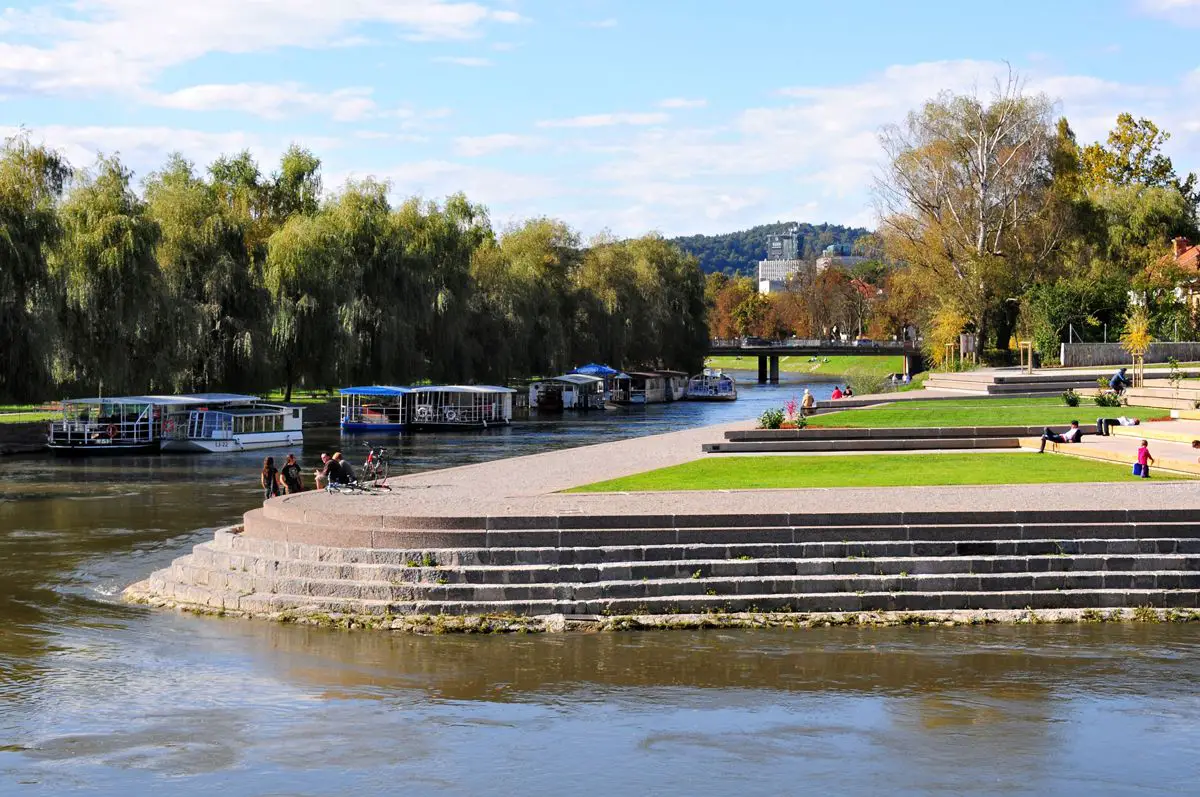
visitljubjana.si
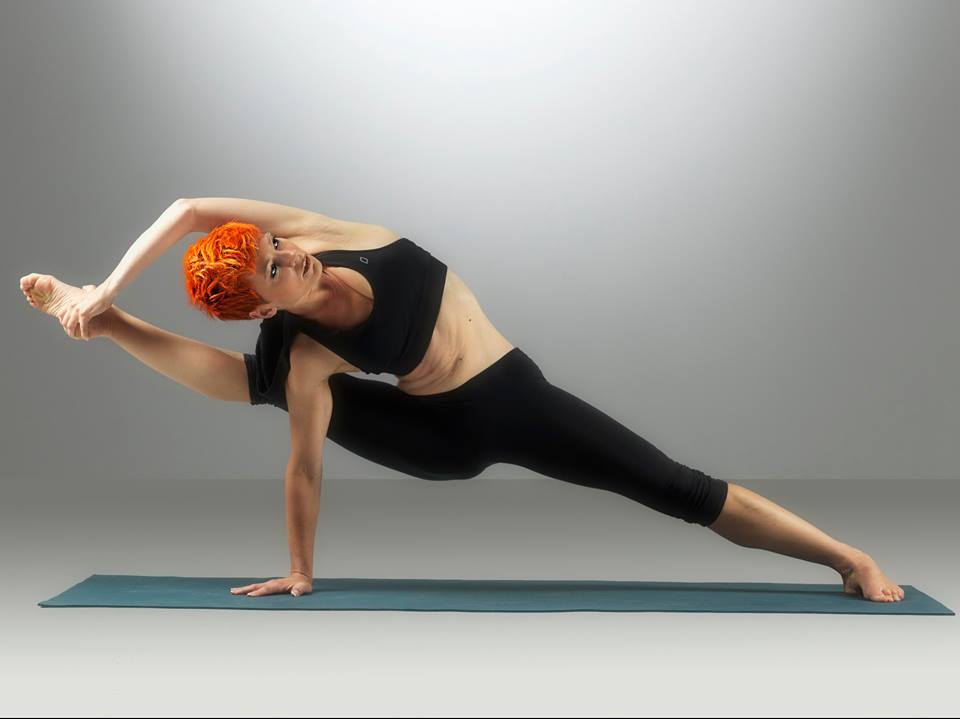
Want to stretch and breath? Then check out our list of drop-in yoga classes for tourists, visitors and the uncommitted. We go to Nataraja Studio, by Dragon Bridge, and here's a story about it.
Prefer to have someone else stretch you? The check out the totally legit massages you can get from Sense Wellness - either in one of their spas or in you home, office or hotel. (And - to repeat - these are legit and non-sexual in nature)
There are some golf courses near Ljubljana, but even ones further away are not far, as seen in our list of all the golf courses in Slovenia, which usually run until the first snow.
![]()
Photo: maxpixel.net, public domain
Daytrips
Most of Slovenia is only a few hours from Ljubljana, and you can easily visit Lake Bled, Lipica Stud Farm, Postojna Cave, Predjama Castle, the coast and other locations, while if you'd like to take a photo of from that bench in Bled, then you can learn how to get there here. If you’re looking for something more ambitious, then check out our recent guide to the 17 members of the Association of Historical Towns of Slovenia. We've also written guides on spending from four to 48 hours in Bled and Piran.
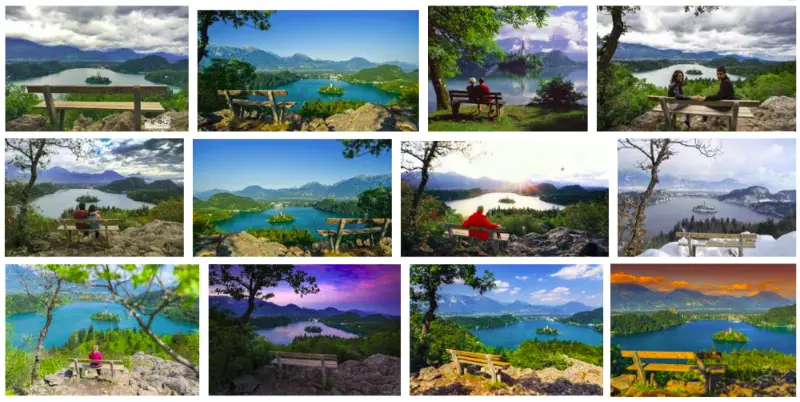
Photo: Google Image Search
Getting around
If you want to get a Ljubljana Tourist Card, which gives you travel on the city buses and entry to a lot of attractions, then you can read more about that here, and if you want to use the bike share system, as useful for visitors as it is for residents, then you can learn more by clicking this. Visitors with reduced mobility will be pleased to find that downtown Ljubljana is generally rated as good with regard to accessibility, and that there’s a free, city-sponsored app called Ljubljana by Wheelchair highlighting cafés, attractions and so on with ramps, disabled bathrooms and Eurokey facilities, which you can read about and download here. Manual wheelchair users can also borrow, for free, an attachment that will motorise their equipment, as reported here.
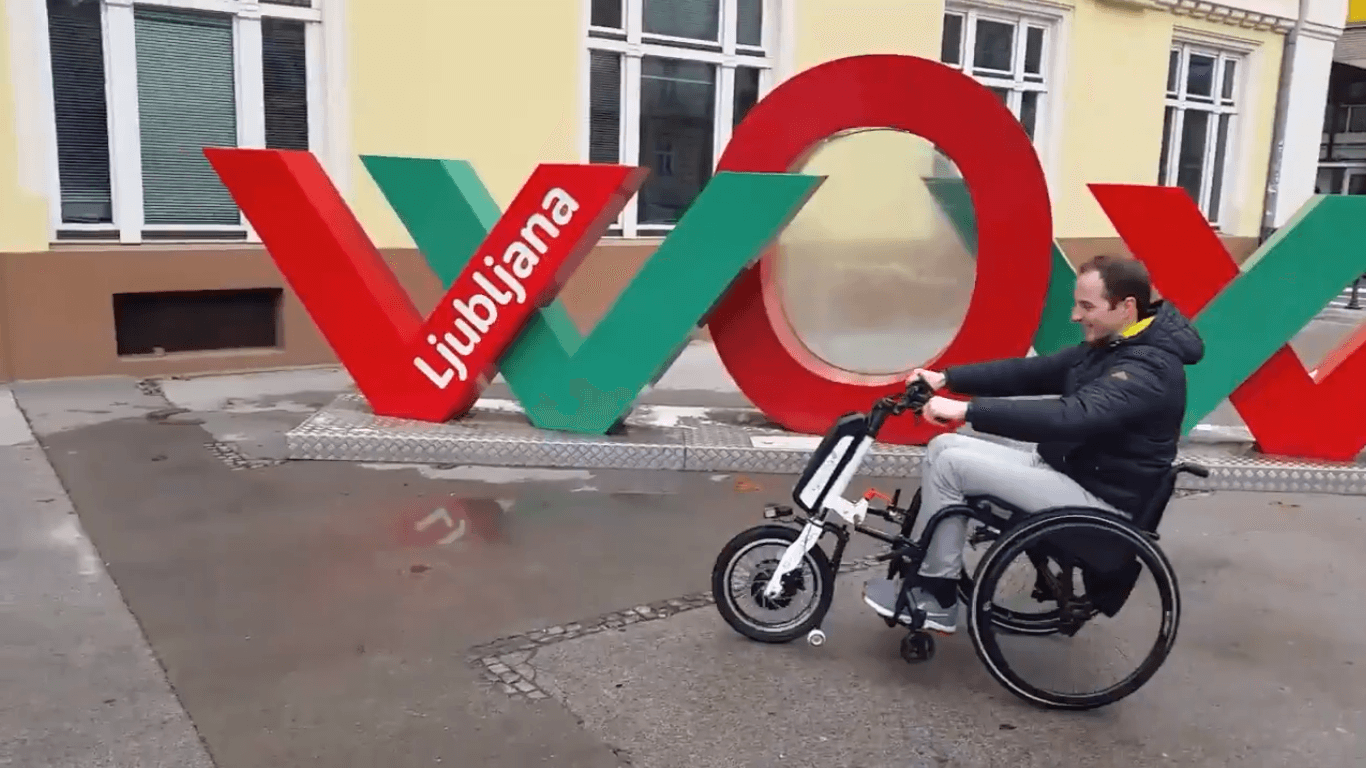
Screenshot from a Twitter video
If you’re driving into town and don’t know where to park, our guide to how to park in Ljubljana is here.
Emergencies
Ljubljana is a small and relatively safe city, but if need to contact the police then there’s a special number for foreigners, and that’s 113.
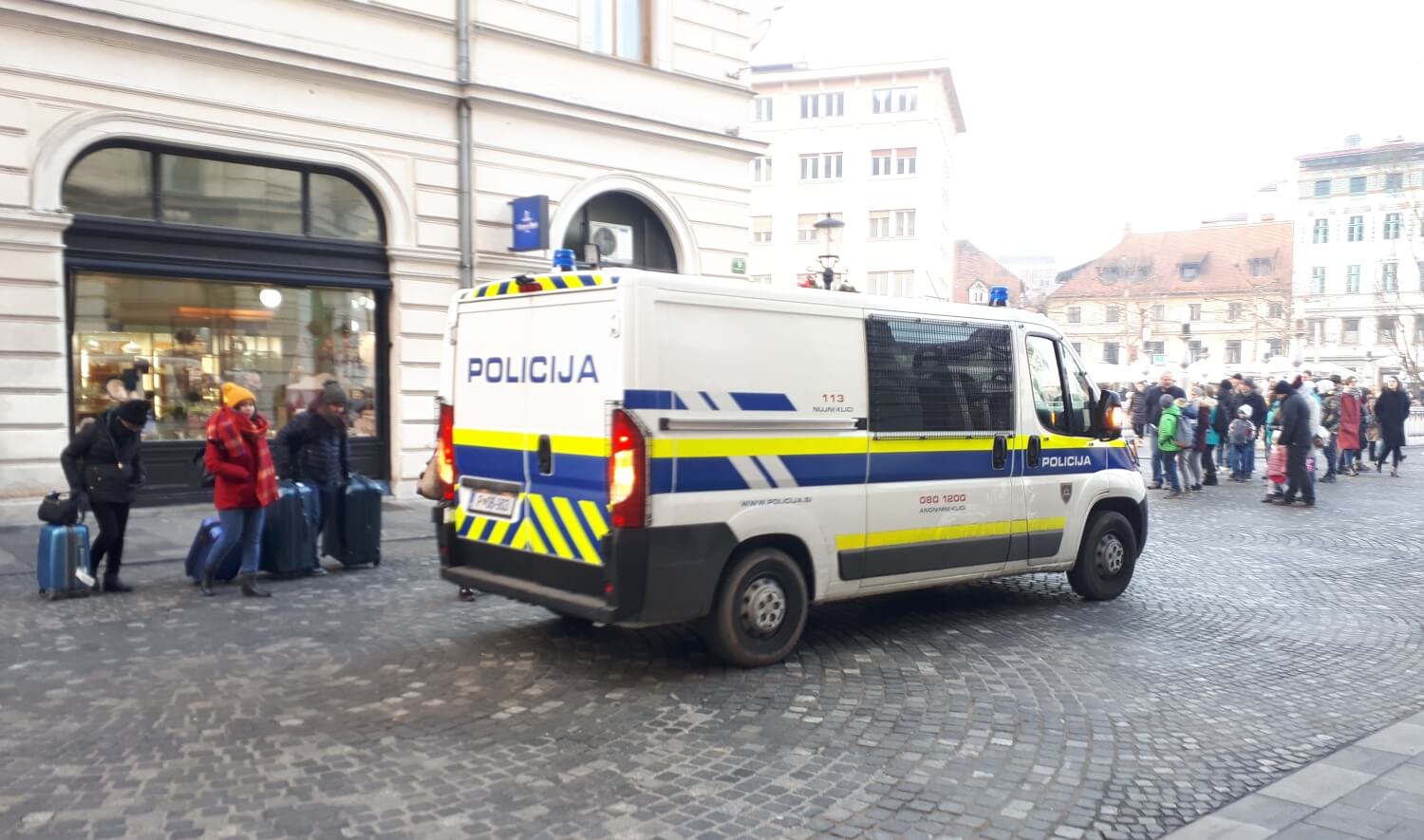
Photo: JL Flanner
There aren't many places to eat after midnight, and most of them are by the train station, as reported here.
Want / need cigarettes but the stores have closed? Here's an incomplete list of bars downtown that will satisfy your craving for the demon weed. While if you’re having trouble with the ATMs then here’s a guide to the Slovene you’ll see on screen. If you get a hangover then find out where to get paracetamol (and prescription drugs) in Ljubljana here, while details on emergency birth control can be found here.
STA, 13 November 2019 - A recent report by the Organisation for Economic Cooperation and Development (OECD) on health indicators shows that life expectancy in Slovenia is slightly above the OECD countries' average. Slovenians eat more fruit and vegetables than the average, while the country's cancer mortality and suicide rates are above it.
Moreover, Slovenians exercise more than residents of the other OECD countries on average, but they also consume more alcohol and cigarettes.
Slovenia's life expectancy is 81.1 years, which is slightly above the OECD average of 81 years.
The country's cancer mortality is quite above the average though - 243 persons die from cancer out of 100,000 citizens in Slovenia, while the OECD average stands at 201. Slovenia thus ranks third in cancer mortality among OECD countries.
Slovenia's cancer incidence is also slightly above the average - 305 cancer cases per 100,000 citizens, while the average stands at 301.
Some 40% of Slovenian adults have two or more chronic diseases, up over nine percentage points compared to the average. Slovenia is also placed above the average when it comes to the number of patients with diabetes type 2 - 7.3% compared to the 6.4% average.
The country's suicide rate is quite high as well - Slovenia ranks third among OECD countries, falling behind Lithuania and South Korea, with 18.1 persons committing suicide out of 100,000 citizens.
Slovenians smoke and drink alcohol more often than the average - almost 19% Slovenians smoke every day. Slovenia also ranks fifth according to the alcoholism rate.
Meanwhile, Slovenians eat more fruit and vegetables as well as exercise more than the OECD average. Moreover, Slovenia ranks below the OECD obesity rates among both adults and children.
You can play around with some of the data below, and the full report can be found here
STA, 14 November 2019 - The government has adopted changes to the parental protection and family benefits act which extend maternity and paternity leave, and improve the financial standing of families when the mother is not employed and of student families.
In case of twins or even more newborns, the father will now get another 10 days of parental leave for each baby. The same rule will apply in case of adoption.
The government explained on Thursday that longer leave for fathers was one of the measures set down in the resolution on family policy for 2018-2028.
Under the changes, foster parents will also qualify for parental leave, getting 30 days for a pre-school child (older than 11 months but who has not yet finished first grade).
The changes also raise the lowest pay for maternity, paternity and parental leave to EUR 402 net a month, which equals the national minimal income.
Also entitled to pay in the same amount will be parents who are not entitled to maternity, paternity or parental pay because they do not pay parenthood insurance - a special tax deducted from monthly gross wages.
Most often these parents are students or student families, but they will be able to benefit from the change only for children born as of 1 January 2022.
Maternity pay for pregnant women who are jobless when going on maternity leave will also be raised to the same sum, under the condition that they worked for at least 12 months in the past three years.
This means that all Slovenian women citizens, regardless of their status, will get a minimum maternity and parental pay, a commitment from the coalition agreement.
Slovenia is quite generous with paid maternity, paternity and parental leave, with the mother being able to take an entire year off for a newborn.
However, of the full 365 days, 260 days can be used either by the mother or the father, although it is usually mothers who stay at home for the whole year.
There is also an additional 30 days of leave as an exclusive right of fathers, which is increasingly popular.
Parents are moreover protected in employment legislation, which prevents employers from dismissing parents on maternity, paternity or parental leave.
STA, 14 November 2019 - Cardiovascular complications in diabetics are at the centre of this year's World Diabetes Day. In Slovenia, some 175,000 people are diabetic, but 15-25% of them do not even know they are sick. Early detection is key and family members can be of great help in this respect, however, only about 20% of Slovenians recognise the symptoms.
Robert Gratton, the president of the Association of Diabetics' Clubs of Slovenia, said at a press conference on Thursday that a healthy lifestyle within the family could be a great encouragement for diabetics and can also greatly contribute to disease prevention in the first place.
Untreated diabetes leaves patients with severe consequences and eight people die every second around the world from the consequences of diabetes complications.
Cardiovascular disease accounts for as many as two-thirds of deaths in diabetics, whereas 70% of heart attack patients are either diabetic or pre-diabetic, said Zlatko Fras, the medical director of UKC Ljubljana's internal medicine clinic.
Andrej Janež, the head of the endocrinology, diabetes and metabolic illness ward believes that tight cooperation between cardiologists and endocrinologists is a must because the right combination of drugs can substantially change the course of the illness.
Tadej Battelino, the head of the endocrinology, diabetes and metabolic disease ward at the Ljubljana children's hospital, was critical that Slovenia is lagging behind other countries in subcutaneous glucose monitoring.
Illustrating the effects of this approach, Battelino said Belgium gave these monitors to all diabetics in the country and despite the cost of the monitors, the country still saved some EUR 300,000 annually because there were fewer complications such as cardiovascular disease, amputations and dialysis.
He also underlined that modern drugs must become accessible to patients as soon as possible. They are expensive, but complications are even more expensive, he said.
There are two types of diabetes. Type 1 usually occurs during childhood or adolescence when the pancreas no longer produces insulin, a key hormone in glucose metabolism.
Type 2 diabetes occurs later in life due to unhealthy lifestyle that leads to reduced insulin sensitivity of cells. This sends the pancreas into overdrive to produce ever more insulin. Ultimately, pancreas is longer able to produce insulin at all.
Overweight is the main single reason for type 2 diabetes, as well as cardiovascular disease. Data for 2016 show that 19% of adults in Slovenia are obese, while 58% are overweight.
World Diabetes Day is observed on 14 November, the birthday of Frederick Banting who, alongside Charles Best, developed the idea that led to the discovery of insulin in 1921.
Learning the language is one of the biggest challenges and most rewarding achievements of living in another country. That’s especially true of a minority language like Slovene, with little global presence, a very limited supply of media, and even less motivation to learn if you live in a place, like Ljubljana, where you can get by in English. So we sent some questions to Bojana Petkovič, of the language school Jezikovno Mesto, with branches in Ljubljana and Maribor, to find out more about her work and how she teaches people to speak Slovene.
How long have you been teaching Slovene, and when did you open your school?
I started to teach Slovene six years ago. I started to give lessons to Spanish and Czech speaking students, as I studied those two languages at University. Then I had opportunity to teach students who came to EVS exchange, and had two groups in two years that I really enjoyed teaching my native language. I am very touched when I hear my students talking in Slovene.
I’ve taught languages for 12 years. I started when I was student. I had great opportunity to teach in six private language schools (at the same time) and also in four public schools (primary school and high school). So I gained a lot of experience how to teach and I also observed how are courses organised in different schools. Then I decided to open my language school in 2016.
I want to offer good experience with learning languages, a lot of opportunities for communication and to get rid of their fears talking in a foreign language. I am very happy the school is growing so fast and so many people trust us and continue learning in new semesters. Some students have been with us for three years, always improving their language skills.
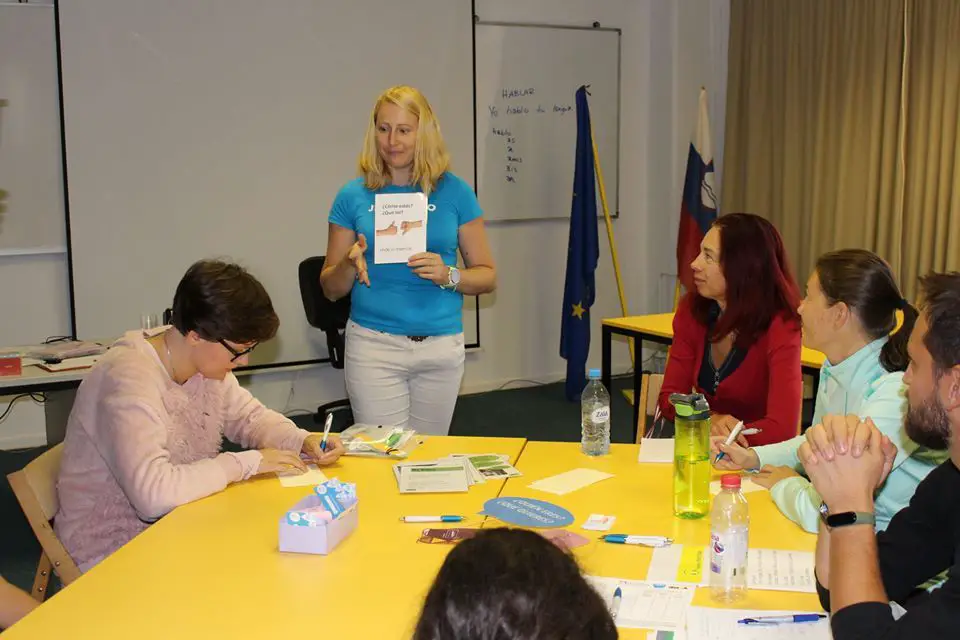
People say that Slovenian is one of the hardest languages to learn. What are your thoughts?
I partly agree. Every language has its difficulties. As a polyglot (I’ve learned seven languages) I can compare them. For example, in English what’s difficult is spelling (speaking and writing are not the same), in Slavic languages we have declination (skloni), in Spanish, Italian, Portuguese and French it’s difficult to choose the right past tense or conjunctive mode.
So while it’s is true that in Slovene are a lot of combination of endings but it is not impossible to learn. It takes time to improve by speaking.
Can you tell us about the typical experiences of foreigners who come to you to learn Slovenian as total beginners, what are the main problems they face?
It takes time to improve by speaking the language, by using it in everyday situations. Maybe it is also difficult to get the stress (which is not always on the same syllable). Students can quickly learn words from everyday vocabulary – what they need (beer, one more please, coffee, bus, …). So we start with topics they are familiar with. Words we use in a context. In our school we prepare materials for playing games and activities and so students are learning in fun way.
When people stop learning on a course it’s very important that they find people to talk with them in Slovene. It doesn’t matter if they don’t use the right endings, it’s about communication in the language. So besides regular courses we also provide courses for conversation, so they can practice and lose their fear of speaking in Slovene.
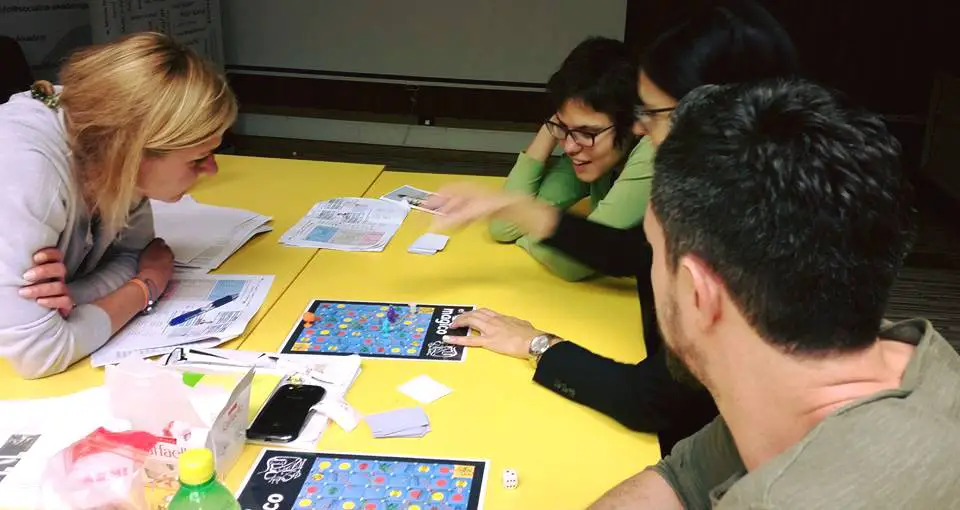
So many foreigners seem to have a mental block about learning Slovenian, especially if they can live and work here without learning the language. How do you 'unblock' that mentality?
We all face with this situation differently. It depends a lot on individual situation, but the learning process is very important. We start with the basics, with simple words, and then we put words together in a sentence. Later we make simple dialogs.
It’s also important that there’s positive feedback from teacher, so that students gain confidence. Teachers also appreciate instant feedback from students, so they can adapt the lesson to them, as maybe they just need a different explanation or more exercises to understand something.
We use a lot of visual material, such as pictures, movies, PowerPoint, colours, cards. I think the most important thing is that our students feel comfortable in their group. So we laugh, we joke and such positive vibes are very important.
Finally, students need to feel a need to learn a foreign language, otherwise they don’t have motivation. And some of this can be done by the teacher, who creates different, useful and interesting tasks for the class and homework.
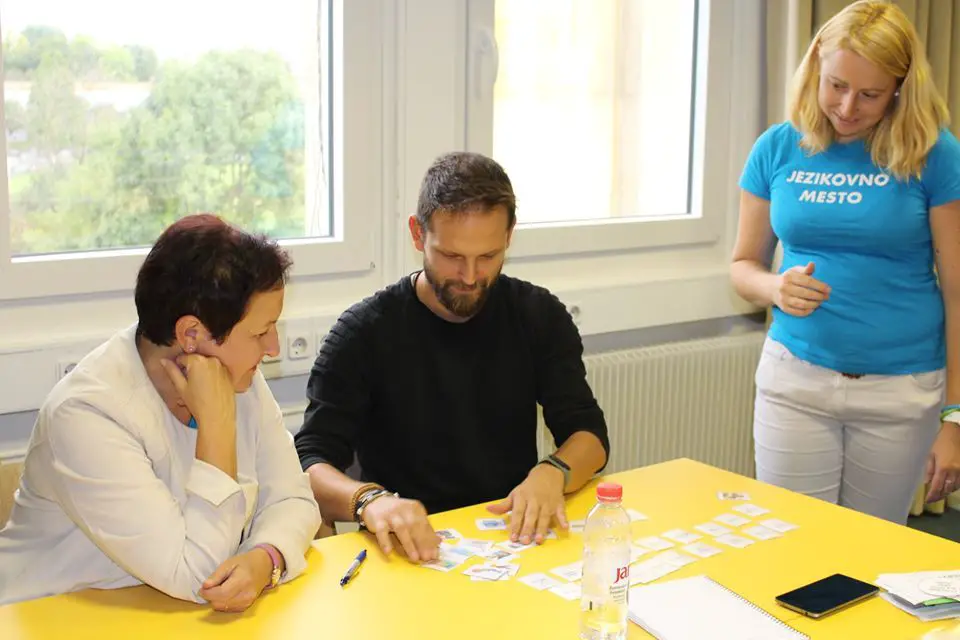
What do you find difficult about speaking English?
I think the spelling and writing are pretty difficult, as well as the pronunciation. English has a lot of synonyms and use a lot of phrasal verbs (look for, look forward, look out, look up …). And different accents -- British English, American English – and a lot of non-native speakers with their own versions.
Learning Slovene is a serious business. Why should people sign up for a course, and what’s on offer with your language school?
First of all, they need a desire to learn, they need to feel that they need this language. To go to good language course is a shortcut to learning a new language. It’s awesome that students can learn language from their experiences – and we also very much support learning outside the classroom, looking at signs, listening to people, reading articles in Slovene, listening to the radio – but it is easier if someone prepares material for you and guides you through the learning process.
In my language school, Jezikovno Mesto, we organise group and individual courses. We have courses for beginners, intermediate levels, we prepare for certificates A2/B1 and B2/C1, and also very popular is the conversation course (Pogovarjajmo se po slovensko). We are teaching in small groups (4 to 8 students) so the teacher can dedicate time to every student. As I mentioned before, we use communicative methods, and we prepare activities, so students can learn by playing games and trying to do different tasks in pairs or smaller groups. The material we prepare is based on everyday situations and it is for all three types of students: Visual ones (they need to see), Kinesthetic (they need to move or to touch material, “words” on cards) and Auditive (they need to hear).
What’s your advice for people learning Slovenian and thinking about giving up?
They can find out what they already know and can use this as a basis to encourage themselves that it’s not impossible to learn. Stop comparing themself to other students, everybody has their own path). Find new reasons to continue with learning. Maybe find some new person to talk to, watch TV in Slovene, watch your favourite movie and read the subtitles in Slovene. It’s important to have good attitude towards the Slovene language. And of course go to group course, so the group will support you and teacher will lead you to the next level. In short, try and have fun with Slovene.

What are some Slovenian cultural products that foreigners who learn the language should be aware of?
I like the book of Noah Charney – Slovenologija (they should read it first in English and then in Slovene). It’s about his experiences becoming a Slovenian husband. Now there’s also a also very popular book called Belo se pere na 90 (Bronja Žakelj). For youngsters there are the books of Desa Muck. But in fact there are many good books, it just depends on the age of the reader and the level of their Slovene.
I also think we have a lot of good music in Slovene, and we listen to Slovenian songs on the courses, such as those by Nina Pušlar, Tabu, Alya, Siddharta, Vlado Kreslin, Big Foot Mama, Kingston, Dan D, and so on.
You can learn more about Bojana Petkovič and Jezikovno Mesto - in both Ljubljana and Maribor - here, while all our stories on the Slovenian language are here
The 30th edition of LiFFe – the Ljubljana International Film Festival – opens today and continues until 24 November, with over 100 films on the programme and screenings in the capital and Maribor, Celje and Novo Mesto.
The first edition, back in pre-independence 1990, was led by Jelka Stergel, who today heads the Slovenian Film Festival, and showed just 13 titles. The programming director is now Simon Popek, and while the schedule has grown the aim remains the same, to present the international art cinema in Slovenia.
Note - this is an international film festival, so do check the language and the subtitles
The programme, which can be seen in full here, is divided into sections. There’s a competition section, called Perspectives, Kings and Queens, which shows the biggest art house hits of the previous year, and Avantpremieres, for first screenings in Slovenia. There are also the Panorama and Extravaganza sections, which highlight lesser known names and genre production, respectively, with dystopian, futuristic South American films getting plenty of screen time this year. Along with these there are short films, children’s films and a focus on films from Cuba. Slovenian titles also be featured, including Gregor Božič's Stories from the Chestnut Woods, which premiered at the 2019 Toronto Film Festival and won 11 Vesnas, the Slovenian “Oscars”.
More details can be found on the clear and easy to navigate website
STA, 13 November 2019 - The coastal towns of Piran, Izola and Koper were flooded during the night due to heavy rain and a combination of a cyclone, southerly wind and full moon, which caused an exceptionally high tide. According to unofficial information, the sea level reached the second highest point in the last 50 years.
Alarms went off in the coastal towns, whose old city centres were under water. In some parts, the water level was 60 centimetres high. The worst hit was Izola.
Major flooding in Piran, Slovenia this evening associated with intense southerly winds from the cyclone over the Mediterranean and high tide! Notice the person walking in deep water. Video by Bojana Francuz pic.twitter.com/Eu3UkjZ13y
— severe-weather.EU (@severeweatherEU) November 12, 2019
According to Koper's tide gauge, the sea level reached 373 centimetres last evening, which the Environment Agency said was a rare phenomenon.
Firefighters were busy all night and their efforts continue as the sea level is expected to rise again this morning, so anti-flooding barriers are being set up.
The Environment Agency expects some 20-40 centimetres of water in the low-lying parts of the cost this morning.
Heavy rain and strong winds caused problems in other parts of the country as well during the night, especially in the north-east and in the west. Rivers may burst their banks today, especially in Slovenian Istria and parts of Primorska.
In 1920 the Rapallo Treaty was signed by the Kingdom of Serbs, Croats and Slovenes (Kingdom of SCS, in 1929 renamed the Kingdom of Yugoslavia) and the Kingdom of Italy in Rapallo. The treaty defined a border between the two countries, assigning one third of the Slovene ethnic territory, Istria and part of Dalmatia, to Italy, which in turn recognized the Kingdom of SCS.
Along the Rapallo border, the Slovenian population of the former Austro-Hungarian Empire was divided into two parts. Slovenes who lived in Gorizia, part of Inner Carniola, Trieste, Istria and the Littoral were soon to experience the pressure of increasing fascism.
Italy entered WWI due to an alliance with Germany and Austro-Hungary that it had been part of since 1882. At the start of hostilities it refused to commit troops, claiming that the alliance was defensive in nature and that Austro-Hungary was the aggressor.
In 1915 Italy changed sides after the Triple Entente (France, Russia and Great Britain) promised it parts of the Austro-Hungarian territories under the secrecy of the so-called London Agreement (Italian: Patto di Londra), signed on April 26, 1915 by the representatives of Italy, the United Kingdom, France and Russia.
Italy pledged to declare war on the Central Powers, which it did less than a month later, on May 23, and was in return promised the following territories in case of the Entente’s victory:
Trst (Trieste), Trento, Gorica, Istria, Protectorate over Albania, the port of Vlorë, Dodecanese Islands, Zadar, parts of Dalmatia, the Soča River Valley and Southern Tyrol.
The agreement became public with the fall of Tsarist Russia, when Vladimir Lenin, a fierce opponent of war and secret diplomacy, in 1917 publically declared that the new Soviet state no longer recognized the Agreement.
In a new international situation that followed with the war’s end in 1918 the United States became involved as well. President Woodrow Wilson rejected Italian claims for Dalmatia, but agreed that the Slovenian Littoral and much of Istria, including Pula, belong to Italy.
Backed with such an international support Italy headed to Rapallo in 1920, where it was to sign a peace deal with a newly established, not yet recognised state.
About one-third of the Slovene ethnic territory remained outside the country of origin, all of Istria, Rijeka and Zadar with their immediate hinterland. The aforementioned territories immediately received a strong wave of violent Italianization through fascist attacks, arson, imprisonment, torture, internment and killing of Slovenes and Croats. Tens of thousands were expelled to southern Italy, and more than one hundred thousand were forced to flee to Yugoslavia and other countries.
Winter equipment is mandatory on Slovenian roads from November 15 to March 15 every year, regardless of the weather. The exception are roads within the coastal belt from Kozina to Sečovlje.
Winter equipment consists of winter tyres with a tread depth of at least 3mm or summer tyres with a 3mm tread depth and snow chains on drive wheels.
Mandatory winter equipment in the neighbouring countries:
Croatia: From November 15 to April 15: winter tyres with a tread depth of at least 4mm or summer tires of the 4mm tread depth and snow chains on the drive wheels are mandatory in the most of the northern roads and highways.
Austria: From November 1 to April 15: winter tyres with a tread depth of at least 4mm or summer tyres with 4mm tread depth and snow chains on drive wheels. In high elevation areas snow chains are mandatory for winter tyres as well. In case of slush or partially snowy roads the use of snow chains is not allowed.
Italy: Every region’s got its own regulations: In Friuli Venezia Giulia winter equipment is mandatory from November 15, in Veneto from November 1, while in Trentino it is only mandatory in case of snowy weather.
Hungary: No dates are specified by the law. In case of heavy snowfall road signs can be placed demanding the use of mandatory snow chains on drive wheels.
The St Martin’s Day (Martinovanje) celebration of this year’s wine is upon us, but November isn’t only for new wine, it’s also for new beer. A time to welcome the change in seasons by picking up something more full bodied and warming, with a little more cheer than usual to ease you into the winter. That’s the idea behind Novembeer, the perfect follow up to Sober October and the brainchild of Ajdovščina’s own Pelicon Brewery.
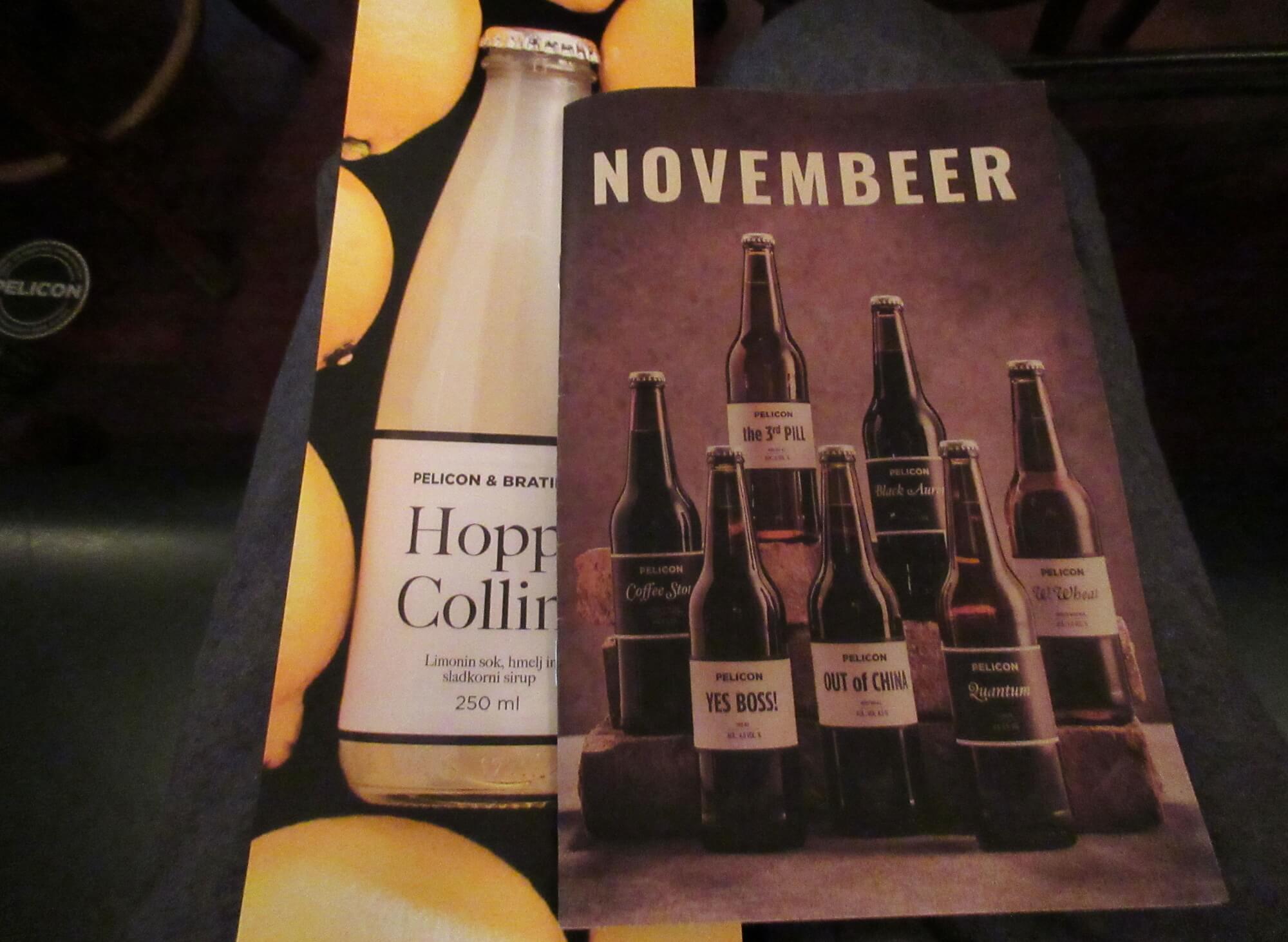
Photo: JL Flanner
Founded in 2013, Pelicon’s already one of the old names on the Slovenian craft beer, making a splash with its early IPAs, distinctive, black and white packaging and often names – Out of China is a play of Ajdovščina, The Third Pill is a Žižek reference, W. Wheat is Breaking Bad, and so on. For this promotion there are two new beers and three variations on old favourites. The first of the new brews is a 6% IPL – or Indian Pale Lager – while the second is Harvest Moon 2019 (5.4%). The promotion also includes some already well-loved beers that are well suited to colder days and longer nights: Black Aurora (a porter, 6.2%), Quantum (a double IPA, 8%), Veliki IPA (a 10% IPA – you have been warned), Coffee Stout (made with real coffee and 8%), and Winter Warmer (a traditional end-of-year beer, with 8.4% of added warmth).
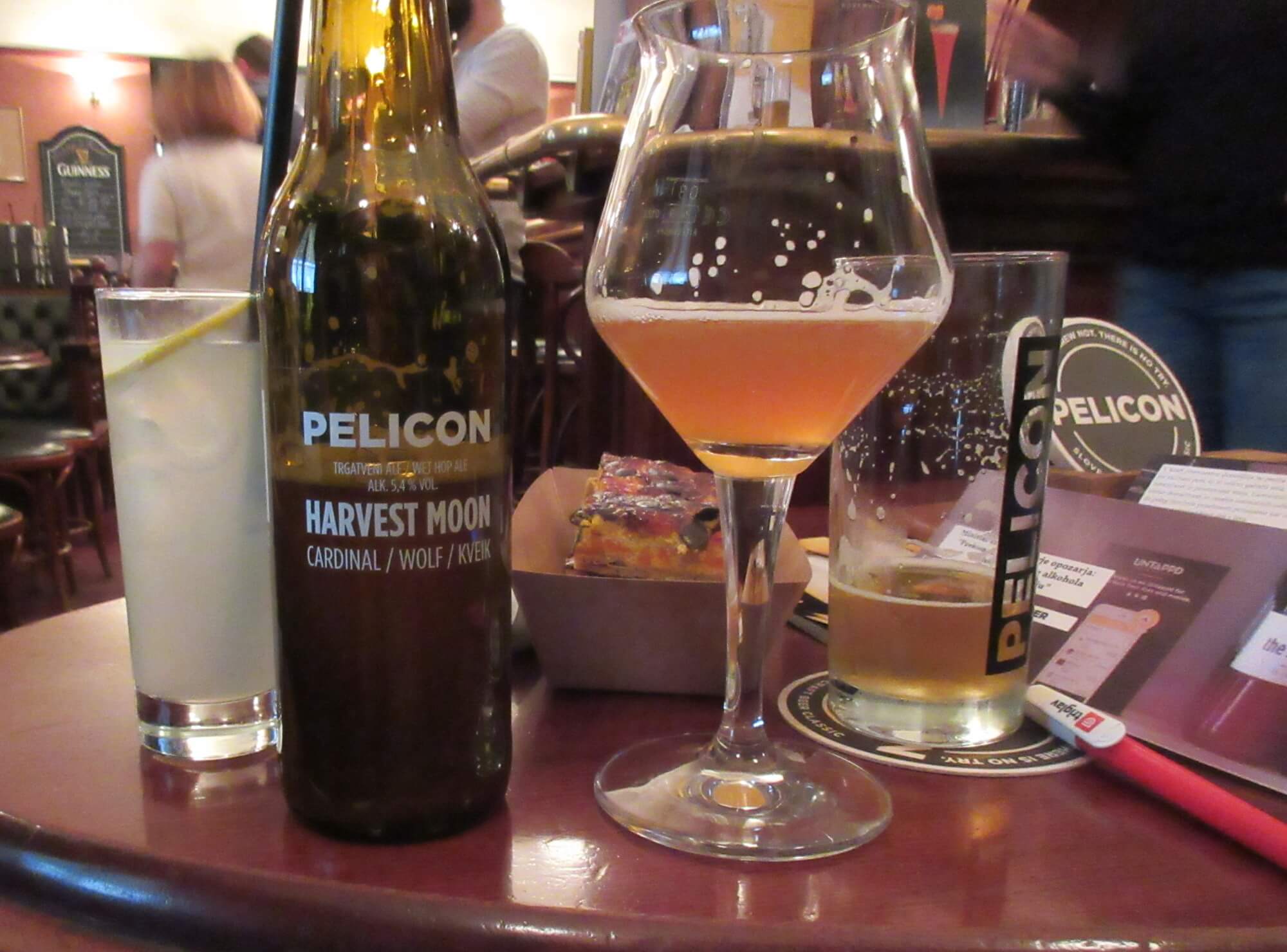
Photo: JL Flanner
While some of these beers can be purchased in bottles, most are making their current appearances on tap. In Ljubljana you can find them at Sir Williams Pub, Dobra poteza - the boardgame café, Patrick's Irish Pub, and Pop's Place. In Maribor you can explore the new beers at Isabella food&wine, while in Ajdovščina you should head to Bar Hiša Mladih.
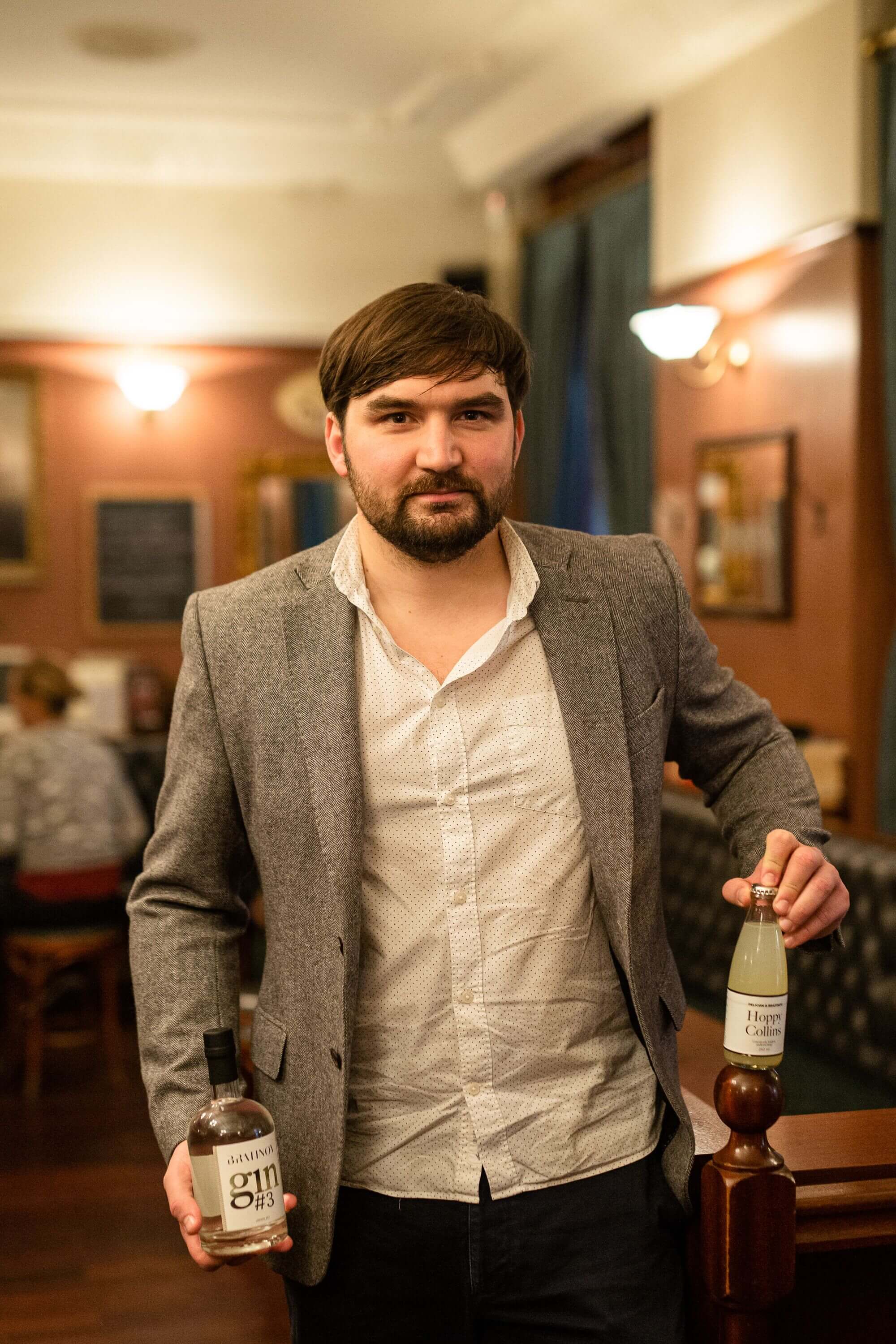
Miha Bratina of Bratinov Gin. Photo: Jan Čermelj
Still, not everyone drinks beer, or alcohol, and thus Pelicon is also launching its collaboration with Bratinov Gin, the Hoppy Collins lemonade. This is a fresh, high quality Slovenian mixer, nad one that you can expect to see at in more and more bars over the festive season.
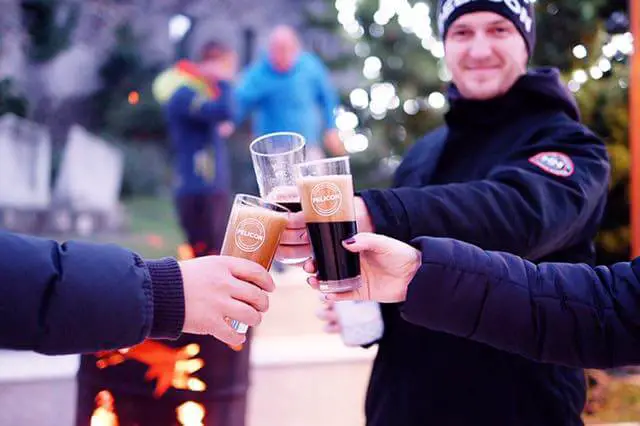
Photo: Pelicon
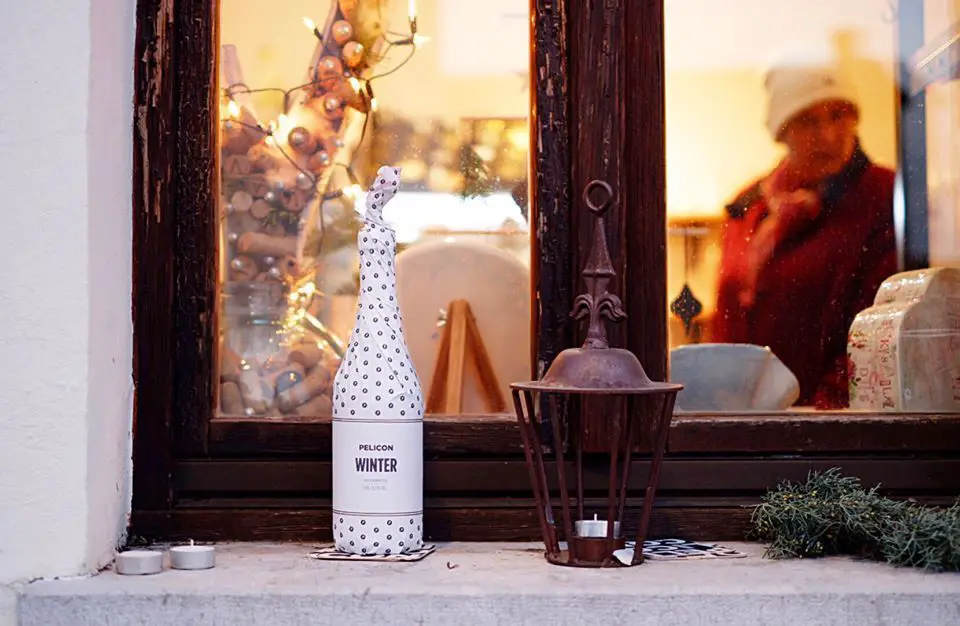
Photo: Pelicon
Up next for Pelicon is another of its international collaborations, this one with the Yeastie Boys team from the UK, as the brewer continues to help spread the word on Slovenian craft beer and share ideas with the best and most interesting brewers around the world.


